The Internal Comms Podcast

Episode 62 – Textbook IC: rewriting comms for a new era
In the latest episode of The Internal Comms Podcast, host Katie Macaulay speaks with the duo who wrote the book on internal communications – literally.
Sue Dewhurst has worked in comms for more than 20 years and now trains thousands of professionals, with her frameworks used in organisations around the world, while Liam FitzPatrick is a change management expert and a lecturer in teams, research and planning.
In this broad-ranging and in-depth conversation, Sue and Liam explore the new insights shared in the freshly published second edition of their book, Successful Employee Communications: A Practitioner’s Guide to Tools, Models and Best Practice for Internal Communication.
They also discuss issues including goal-setting, outcomes versus outputs, running your own intelligence operation and knowing how your audience thinks. They emphasise the unmatched importance – and privilege – of listening to people, and reinforce that IC is just as much about what people need as the organisation’s overall goals.
Though Sue and Liam agree that the pandemic has proven the power of IC, they warn organisations not to get complacent. In a world where purpose has become the glue that holds a company and its employees together, it’s essential to avoid backsliding. After all, IC isn’t just about what we say, it’s about the actions and compassion of the organisation.
If you have any thoughts or comments on this episode, please share them using the hashtag #TheICPodcast. And make sure you’re following us @abthinks.
Transcript
[Katie 00:03]
This episode of The Internal Comms Podcast is brought to you by my very own Friday update. Would you like to get a short email from me, never more than five bullet points long, giving you my take on the week’s news from across the world of communication? This might be the latest reports, books, podcasts, conferences, campaigns that have caught my eye during the week. I always limit myself to just five nuggets of news s you can read it in record time, but still feel (hopefully) a little bit more informed, maybe even a little bit more uplifted, as you end your week. Now, this is a subscriber-only email, which was initially intended just for colleagues and clients. I don’t post this content anywhere else, so you do need to sign up. But that’s super easy. Simply go to www.abcomm.co.uk/Friday, and just pop in your email address. It’s equally easy to unsubscribe at any time. So, give it a try. That sign up page again: www.abcomm.co.uk/Friday. And thank you very much if you do choose to be a subscriber.
Welcome to The Internal Comms Podcast with me, Katie Macaulay. Every fortnight I sit down with leading lights from the world of communication, business and academia to tease out the smart thinking, the fresh ideas and new tactics for improving the way we communicate at work. Joining me for this episode is the dynamic duo that is Sue Dewhurst and Liam FitzPatrick. They are the authors of the book Successful Employee Communications: A Practitioner’s Guide to Tools, Models and Best Practice for Internal Communication.
With the second revised edition of this book just hot off the press, this seemed like an ideal time to invite Sue and Liam back on the show. When I first interviewed them it was in late 2019. That’s episode 17, if you’d like to check it out. What I wanted to find out now is whether their thinking, whether their approach to internal communications, has changed over the last three momentous years.
And, also, Sue and Liam are all about researching, teaching and implementing best practice. Now, I love a model or a framework, not least because it helps bring order and consistency to the way that I might go about solving a problem. But what I especially like about Sue and Liam’s work is that it’s highly practical. So, we talk here about the best way to set goals, take briefs from our stakeholders, develop messaging, audit channels and content, gather intelligence, and much, much more.
Sue has worked as a senior internal communicator in-house and as a consultant for more than 20 years before she went on to specialise in learning and development, and has since trained thousands of leaders and comms professionals. Her models, her frameworks are used in organisations worldwide. Liam is particularly experienced in change management, PR, and internal comms. He’s worked in-house and for major consultancies. He lectures on developing teams, research and planning, and has served as an external examiner at UK universities.
What was especially lovely about this interview is that we were able to record it in person. This turned out to be a really broad-ranging, in-depth conversation. And, as ever, Liam and Sue are very generous with their thoughts, with their ideas and their experience. So, without further ado, I bring you Sue and Liam.
Sue and Liam, welcome back. Your second appearance on The Internal Comms Podcast. Thank you for being here in person as well.
[Liam 04:43]
It’s nice to be asked back. We obviously didn’t let ourselves down too much last time.
[Katie 04:47]
You were one of the most popular episodes, actually. I just checked our figures. So, thousands of people have listened to it around the world. So, yes.
[Liam 04:53]
I’ve got big extended family.
[Katie 04:57]
We’re here to talk about the second edition, hot off the press, of your new book, Successful Employee Communications: A Practitioner’s Guide to Tools, Models and Best Practice for Internal Communication. But, given all that’s happened over the last three momentous years, (let’s call them that) I must ask, when you were embarking on this second edition, did you do so with a degree of trepidation?
[Sue 05:24]
I think it was quite exciting, really. Because, yeah, an amazing amount of things that happened in those three years, hadn’t they? None of them very pleasant. You know, COVID-19, a lot of upsetting things around the social justice movement, although lots of moves forward as well. Climate change, good things in the purpose world. So, to be honest, I was really excited about being able to dig into the case studies, because I think it has been a time when comms people could stand up and really make a difference. And there are a couple of academics that I knew had done good stuff. And it’s just an excuse, isn’t it, to be able to pick up the phone and talk to them. So, I was quite excited.
[Liam 06:01]
I think, yeah, I think the excitement wanes once you’ve got into the work a bit. But, yeah, I think you’re right. And I really enjoyed the piece around you’re saying about actually just going and talking to people again. And, actually, once you’ve got a book, people then seem to be a lot more willing to talk about case studies as well. And we’ve got some great case studies in there of people talking about practical things that they’ve done, and how they’ve changed their processes and stuff. So, yeah, it was quite exciting at the beginning. And it was very good when we finally delivered the manuscript and the publisher said thank you. The bit in between, though, I wouldn’t recommend.
[Sue 06:35]
Well, the good thing was, you know, we weren’t really allowed to see each other. So, we couldn’t, you know, do each other any damage when we were driving each other completely mad again.
[Liam 06:44]
We did forget about that. Because Sue and I’ve worked on and off together over the years. And it always starts with the kind of bundle of excitement and then gets quite close to… I mean, I’m a very patient person, but Sue gets very close to murdering me at various points in the process.
[Katie 06:59]
Well, we’re gonna get into the weeds, as it were. Into the detail. But just for a minute, stepping back and looking at the bigger picture, what do you think has been, or perhaps we should say will be, the lasting legacy of the pandemic on our profession? There’s a line in your book, you write “No-one ‘sane’ now doubts the importance of communication at work.” But do you have any reflections on, as I say, yes, that lasting legacy?
[Liam 07:29]
Our experience over the years is we are old enough to have been through several revolutions in the world of employee communications. And yes, I think progressively people are finally working out that communications is important. And it can be done well. And if done well, professionally, it can make a difference. And there are more senior leaders out there who now have experienced good communication, yes. The one warning we have is that we’ve also both experienced how things backslide very quickly. We both… everyone knows that we both met when we were both working for separate companies going through catastrophic, existential crises. And we both said, “Oh, yeah, this is you know, this is fantastic, we’re invited into meetings with senior leaders, we’re consulted on things.” But we both had the experience of the moment the crisis passed, the organisations for which we worked kind of started backsliding very quickly. And the word of caution that we probably put out there is “Don’t get complacent guys.” You will, we were important when we were needed. But it could well be the organisations we work for will need reminding again of the importance of why great communications makes a difference.
[Sue 08:43]
It’s tempting to assume now that everyone gets it.
[Katie 08:45]
Right, okay.
[Sue 08:46]
So, as we said, nobody sane doubts the importance of internal communication, and then we sit here what, a few days after P&O Ferries have just treated people absolutely appallingly. And you think ‘Well, communication isn’t just about doing a three-minute zoom script thing? It’s about the actions of the organisation and having some compassion.’ So to me, that’s, it’s a big wakeup call that says nobody can be complacent.
[Katie 09:16]
There seems to be something of a golden thread running through your book. And that’s the importance of really knowing your audience. I think it’s, I mean, it’s mentioned in I think every chapter, whether you’re writing about conducting IC audits, crafting messages, measuring our impact as a profession, would that be a fair assessment? Am I reading that right? And, if so, what does knowing your audience actually look like in practice?
[Sue 09:45]
I think it is a fair assessment. I think the first edition very much had the outputs versus outcomes running all the way through it, and this has that. But it also has this second thread now of knowing your audience and listening. And, I think, for me, there’s something about, I think there’s a danger of assuming that we know what’s going on from the ivory tower of head office, if you like. And I always find it fascinating to talk to, you know, engineers that come to the house or friends or whatever. And I was actually talking to a friend this week, who works for an organisation about which I’ve read lots of really great case studies over the years. And what she told me about the way communication was happening, that she experiences, is horrific. And, you know, her colleagues are leaving, and I thought, ‘Gosh, this organisation really should know this.’ And I think it’s really easy not to know it.
And, I must admit, when I was writing the chapter about setting objectives, I felt a little bit uncomfortable with it, because it felt like it’s all focused on what the organisation wants, you know, what’s the business needs. ‘What do we need to get people to do, in order to meet that business need?’ And I started feeling a bit uncomfortable. And I sent a note to Emma Bridger, who, of course, has written a lot about employee engagement and employee experience, and said, “Emma, can we get your perspective on this?” And she has a framework which I really like where she says, ‘When you look at the needs of the business, the need of the person, and the needs of the job’ and I liked that because it took it away from the business always being the start and end point and said, ‘Well, it’s not just about what the business needs, it’s about what the people need.’
[Liam 11:30]
And I think the thread that you’ve picked up, the golden thread, also comes out in the sense of when you think about where the value is that you add as a communicator, is that some of our skills around craft, skills around our ability to make stuff happen, or to be great writers, or to be good project managers or to be good strategists. But, very often, the real value that our senior leaders really appreciate from us is the fact that we’ve got an ear to the ground, and we know what’s going on in the organisation. And, if you’re a senior leader, you’re surrounded by people who want you to have their version of the truth about what employees are thinking. I think one of the great beauties of what we do as a profession, the one thing that keeps me interested, is actually listening to employees, listening to people talk about their work, talk about their experiences, why they don’t believe the BS coming out of the executive floor, why they’re worried about, you know, even trivial things, seemingly trivial things, but listening to that, I just think it’s one of the great privileges of what we do as a profession is listening to people and hearing what they think. And if you don’t know it, how can you craft messages for people? How can you design channels so that, to reach them if you don’t know what they’re doing, what their life is like?
[Sue 12:39]
It’s quite a superpower, I think, that we sometimes miss is the whole power of insight. And I’ve spent some of my, I’m gonna say happiest moments, I’ve also spent some my time being ripped to shreds in focus groups. But I guess lots of people, like me, came into communications, because I wanted to make a difference to people. And certainly in focus groups, you can, you know, people tell you what’s really happening, and you can actually come out of that room, or I guess you can come away from a computer screen these days. And you can make something happen that changes things for people. And yeah, I’m quite, I’m always amazed that more people don’t want to do that.
[Katie 13:17]
Yes, I agree. I actually think it’s quite a privilege sometimes to get this unvarnished version of the truth from someone who is sharing all with you that you might otherwise not get to hear. And whether that’s somebody you know, working the machinery on the front line, or whether that’s the chief executive always felt that there’s an element of feeling quite privileged about it somehow.
[Liam 13:39]
When you’re sitting down with, you know, your stakeholder or chief executive or divisional director or, you know, some functional leader, the thing that makes us worth listening to isn’t just because we know how to write a video, turn out a well-crafted email or newsletter, then makes it worth listening to is we can say, “Actually, boss, that’s gonna go down like a lead balloon for these three reasons….” or, you know, “Why don’t you say it like this, because people will be more receptive to you hearing it like that…” And I think that just, you know, is so, you know, so powerful if you can do that. And, as I say, it’s part of the joy of the job.
[Katie 14:15]
What role does sort of segmentation and audience segmentation play in that, and now I’m seeing more organisations, and I see teams talk about personas, whether they’re actually developing them holistically or not, I’m not sure. But yeah, what role does segmentation play in that and potentially persona development?
[Liam 14:35]
Well, I think the first thing is, obviously, one size never fits all, unless you’re an organisation of three people, you know, you’re- everyone’s going to hear things differently. And a communicator who understands their audience also understands the kind of nuance or the gradations in that audience about how they think, how they behave, what matters in their life. There’s no substitute for going out and talking to people. There is a lot of talk about personas and I think we as a craft have learned a lot from people like project managers and IT who deal with an awful lot, you know people like HR starting to do it in terms of designing, you know, benefits packages. We did do quite a lot of asking around for, looking for case studies around personas. And we found that very few people were actually doing the whole persona thing. But people were doing, taking elements of the idea of persona and learning from it. The main persona case study we’ve got in the book is from a company called Mersk, where they use it as a way of actually understanding potential customers for particular product sets. But it’s been developed by someone with a background in comms.
[Sue 15:41]
It’s nice that it takes us beyond demographics, I think, because I think we have been very reliant on HR stats type things for a long time and gone with demographics. So, I think the good thing about personas is at least it’s taken us more in the direction of emotions and motivations and attitudes.
[Katie 16:01]
Let’s talk about the value that we deliver in IC. There’s an interesting diagram on page five (I think page five) of your book that explains the four ways we can add value. But, crucially, I think, if I’m reading the chart, right, it suggests that the higher the strategic impact of our work, the more difficult it is to actually tangibly measure that impact accurately. Would that be a fair reading of the diagram?
[Liam 16:30]
It sounds quite good, actually. A great description. Why didn’t you write the book? It’d have been a lot more succinct than we were. So, Sue and I worked on and off on things like competencies and role designs for a very long time. And one thing we’ve always been really careful to state is that if you work in, if you’re, the main focus of your role is in content production, or product management that is not necessarily a low-value activity. However, one of the beauties of what we do as a profession is we get to stick our nose into places where it doesn’t belong. And the skills that we’ve got and the knowledge that we’ve got brings us into all sorts of really useful places in organisations.
So, quite a lot of the time, we know we start our role because we can make stuff happen, we can make the newsletter happen, we can get content out there digitally. But because we understand the audience and we’re successful that we then get invited for our opinion into doing other things, perhaps advising on what’s the best way and then progressively morphing into having conversations with senior leaders, which actually have a very, very small communications component.
And I think when you’ve been around for a while in an organisation, you will have had that experience to a greater or lesser extent. As someone who does audits – and you’ll experience this all the time because you do so many audits – you’ll go into an organisation, you’ll go, ‘Right, let me try and define what the value should be from having a trusted advisor to senior leaders.’ And you can’t quite put your finger on it. But if you’re senior leader, and you’ve experienced a great communicator, you’ll know it, and you’ll spend your life looking for one. I’ve got a client at the moment, who keeps saying to me, “Oh, I just want someone like x.” And she keeps referring to someone who was her comms manager at her last big role in another corporation. And that’s what she wants to be caught. She can’t put a finger on it, but she knows what that great communicator looks.
[Katie 18:29]
It comes back to what you were saying before about now there’s much more demonstration of our value, which means that when leaders see it, they get it and they want more of it. Yeah, absolutely fascinating.
[Liam 18:41]
When we first started doing the Melcrum Black Belt a million years ago, we referenced quite a lot of the work of chapter then called David Maister. He wrote, about what 20, 30 years ago, and it was aimed at the senior partners of law firms and accountancy firms about professional services. And he talked about, the book was called The Trusted Advisor. I think it was the guy who first coined it
[Sue 19:02]
It was Maister, Green and Galford.
[Liam 19:04]
Maister, Green and Galford. That’s it, yeah. And, and he talks about, you know, if you look at the senior partners of a law firm, or a big firm of accountants or any professional services firm, the value that they generate is nothing to do with their core competency of being a lawyer or an accountant. It’s about actually being trusted as someone you can go talk about issues with generally. And there are communicators out there who do that.
[Katie 19:30]
I love that thought, that actually your professional qualifications are the chips to play the game. But once you get in there, it’s something else that matters far more.
[Sue 19:40]
It’s a great book, actually, for communicators. Trusted Advisor, Maister, Green and Galford, I’ve recommended it to so many people.
[Katie 19:46]
Links in the shownotes listeners, as always. Let’s talk about the importance of getting the basics right. You use this brilliant analogy and when I read it, I thought ‘That’s so simple, but it really makes sense.’ You can’t imagine an IT director talking to an executive committee about the strategic direction of IT, for example, if their computers don’t work, or the email’s been down for a week. So, I was thinking to myself, ‘That analogy makes sense.’ But in our profession, what do you see as the basics? And is there actually a little bit of, I don’t know if the word is ‘ambiguity’ here, but a lesson we’ve learned through the pandemic, have these become actually foundational building blocks on which everything is based and without them, it all falls apart? So, I don’t know if that was much of a question.
[Sue 20:33]
I think it’s really interesting question. And, yeah, if you look at the pandemic, I mean, just the basic channels, infrastructure was a big one, wasn’t it? Because suddenly people were not in offices anymore and were not set up to work from home. And I think some of the first cases that we talked to people about were, for example, of a rail operator, where they suddenly had to get people set up at home. A bank that started doing vlogs, and because, digital radio, because they were looking for well, how else can we communicate with people because they’re not in the office anymore? And if you haven’t got the infrastructure, you can’t do anything.
[Katie 21:10]
Yeah, yeah.
[Sue 21:11]
I mean, you literally cannot reach people. So, we do talk about outcomes and outputs. But if you haven’t got the infrastructure you can’t do anything, can you? And I think there’s also something around messages. If we think back to the early days of the pandemic, it was overwhelming, wasn’t it, the amount of stuff that was coming out? And I do remember, I think probably driving my husband mad, frequently, when Boris Johnson did a lot of his communication, and I remember him doing a peak time television broadcast, quite a long one. And I thought, ‘You’ve got millions of people watching you. And this is, like, the worst example of a senior management thing I’ve seen, where you’re waffling on about nothing.’ And then, you know, the next day started to peter out things like ‘We need to get people to wear face masks.’ You know, ‘They need to come back to the office on Wednesday’ say, ‘Oh, no, they don’t, it might be Tuesday and we’ve not told the employers yet’. And I just thought, ‘Get the message, right! For goodness sake don’t spend 25 minutes blathering on about nothing.’ So, yeah, as you can tell, I felt quite passionately about that.
[Katie 22:20]
We saw some great examples of how not to do it.
[Sue 22:23]
Yes, exactly. And clear objectives. I think with that as well, you know what exactly we’re trying to do here. And I know we’re talking a little bit about behavioural science. But still in the pandemic, we did interview a behavioural scientist in the book, and he talks about the wearing of face masks. And the idea that a lot of the messages we gave out in the pandemic were ‘Wear your face mask’, which meant lots of people wore their face mask, just on their chin. No, you know, just undone and he said, ‘You’ve got to get the message right. You’ve got to think about what is the objective here? If it is to get people to cover their nose and mouth?’ Get the message, right, that means they cover their nose and mouth. So. I’m going to choose infrastructure, messages, objectives, as the basics.
[Liam 23:08]
Yeah, I think I think those. Yeah, those core essentials, I think that’s a really, really sound point. Because, as you say, there is a lot of value that we can add. But if you’re sitting in a room with some senior leaders and they want someone to get their communication out to the audience, you talking about, you know, waving your arms around and talking about, you know, airy fairy kind of wider issues, they’re not gonna listen to you. So, you need to, you know, you need to get those essentials and use those essentials as your springboard into making the difference. But if you neglect the essentials, then you’re probably not gonna be around for very long.
[Katie 23:44]
It also probably explains why I think I saw this in a State of the Sector survey this year. There seems to be quite a lot of IC teams, either they’ve reviewed the effectiveness of their channels, or they’re about to review them, because in a different world of work, the old channels aren’t necessarily as effective or may be completely ineffective, I guess. So, that’s probably another essential step at the moment is to sort of check what’s worked.
[Liam 24:13]
That’s very fair point. I mean, I know the training that I deliver, I talk about, you know, ‘These are the essential channels you need to think about.’ And it’s probably time to update, because I think no one really knows. I think it’s going to take a while for it to all settle down. But I think if you keep plugging away, doing what you’re doing five years ago, you’re probably not going to have the right mix, are you?
[Katie 24:34]
You quote the phrase, “Come with data, leave with respect.” We’ve heard that a few times, actually, I think on this podcast, and you asked the question, who do leaders in your organisation turn to? You’ve already talked about this in terms of looking for that unbiased guidance and a complete picture, Liam, of what’s really going on. Where have you got to in your own thinking about gathering and using data?
[Liam 24:59]
“Come with data, leave with respect.” I don’t know, where I first heard that, I’d like to, I think a lot of people believe that I coined it and I’m not gonna disabuse them, really, if it gets me free beers. I mean, I think there are probably a couple of ways of looking at it. One is making sure that the data and information that you have to demonstrate your mastery or understanding of the audience is really super important. But, a lot of the time, for organisations, gathering a lot of data is a major challenge and, indeed, actually doesn’t necessarily take you where you want to go. One of our case studies in the book for Jo Osborn of Reckitt, she says, well, they gather data, but they’re very careful not to get data blind, and they try and leaven the hard facts and numbers with their instinct and their sense of what’s going on.
And, so I think we found it quite easy to talk about running your own intelligence operation. So, an intelligence operation is, you know, it’s split into kind of, you’ve got three main parts, you’ve got the data gathering, or the insight gathering. They’ve got their sources and methods, and they’re listening to people as well as looking at stats, they’re looking at users and what people are doing, but they’re out there talking to people. There’s an analysis part of the job where you’re going out and thinking, ‘Okay, what am I hearing? What does this tell me?’ And then there’s the third part, which is the reporting part. And, you know, an intelligence agency will have a reporting officer whose job is to sit down with government ministers and explain what this implication is, and you know, the implications of their insight is. So, our job is, as communicators, to run our own intelligence operation and to be the person that senior leaders in our, you know, our areas, can turn to and know that a) we’ve been out there talking to people, b) that we’ve thought through the implications, and c) we’re presenting it in a way that helps them make communications decisions. One of the big mistakes I think a lot communicators make is we rock up with data and go, “Hey, look how busy we are. Look how important we are, we’ve done, you know, we did 14 podcasts and look at the volume of traffic we’ve generated on Yammer and isn’t our amazing content on you know, workplace.”
No one cares about that stuff. What they want to know is ‘How do I get business results? And how does communications help me get there?’ And a really good intelligence-led communicator is someone who’s sitting down going, “Well, we did this last month, and this is the result we got is that well, you want to okay, this is what we’re planning on doing next month? Is that going to get us the result we want? Okay, let’s how do we modify that? How do we work?” And, so, thinking through your data gathering from a standpoint of ‘What’s the end user going to do with it? And how do I get them to make good decisions with it?’ is the way forward. So, think about yourself as an intelligence operation. That means you’ve got to get out and about, means you’ve got to go and have coffees, you’ve got to be finding reasons for striking up conversations. If there are such things as parties anymore, you gotta go to them. Those sorts of… so just get out and about. And listen.
[Katie 27:59]
It’s interesting, you talk about the difference between outputs and outcomes. And I have this conversation quite a lot with clients, to be honest about, well, there’s nothing necessarily totally wrong about measuring clicks, likes, shares, dwells, downloads, whatever it is, but, as you say, that doesn’t tell you anything about whether behaviour, understanding has changed, whether there’s a new action as a result of reading any of that stuff. And I keep coming back to and I just want to check this with you: is there any other way of measuring that, apart from in qualitative research where you ask people whether they’ve used, an opinion has changed or whether their understanding has deepened? Or whether the motivation for doing something is X or Y? I mean, am I wrong? Is there any other way of doing it?
[Liam 28:49]
I don’t think there are, I think that, I think the old ways are still valid. It’s just that we probably have a better range of data and tools at our disposal now to see what you observe the behaviour of people indications terms. So, we can see clicks and likes and dwells and those sorts of things. But as Jo Osborn, says: don’t get data blind. Data is only useful, though, if you know what it’s telling you. And the only way you can make sense of it is actually knowing your audience better than anyone else, which we said before. I don’t know if I mentioned it last time, one of the best people I’ve ever had, I’ve ever worked with. She was a really heavy smoker. And if she’s listening, she knows exactly what I mean. What it meant is if you sent her an email, she wouldn’t just go and you know, wouldn’t just reply to them. It would be a cigarette opportunity to leave the building. We were on, were operating on a big campus up in Coventry. And she’d go to the other building and she’s going to have a chat and then she’d have a cigarette on the way back and if you bumped into someone, you know, that was another cigarette opportunity. What it meant was that she knew absolutely everything that was going on on that side. And if you wanted to know something, you’d just ring her up. And if you saw some data, she will say, “Well, you can interpret it in two ways, but actually, based on what I know, I think this is the truth of it rather than that.” So having those connections and that network is what makes sense of the hard data, the hard facts and figures.
[Katie 30:14]
And also as you’re saying, you know, don’t get data blind, look for the actionable insight in the data. I think that’s the thing I always get cross, frustrated by when I see lots and lots of data from a previous engagement survey or IC audit. There’s all these stats and figures, and I’m left thinking, ‘Well, great, but what’s the actionable insight? What can I do that will make a difference that’s buried in these statistics?’
[Liam 30:40]
Yeah. And it’s quite interesting and a really good example, actually, because a lot of employee engagement surveys and the old, old style ones actually kind of outsourced that to managers. So, they say, ‘Here’s a bunch of data, come back with your action plan now, or hang in there.’ All you can hear is the sound of hands being washed somewhere in an HR department. And then managers get this data and go, “Where it tells me that of my 25 staff, 15 are unhappy and ten are delirious, what am I going to do?” And that’s one of the one of the challenges that a lot of times managers look at it and go, “I’ve got no idea what to do with this data.”
[Katie 31:13]
An essential part of being an effective comms professional is obviously identifying the real problem that needs fixing. And this came out quite strongly in your book, how should we respond to a stakeholder who says, for example, “I want a set of posters and intranet banners about my wonderful new change programme.” Sue, you mentioned there are three questions to ask at that moment. Just wondering if you could share those with us?
[Sue 31:40]
I can, I can. I think the temptation is, isn’t it… It feels a bit infuriating when somebody comes along and it seems as if they think they know more about communication than us because our brains are primed to like status. So, it’s quite natural that we would do. I think it’s worth reflecting that it’s often suggested that we should start asking ‘why?’. You know, “Why do you want a poster? Why are you asking me this at the last minute?” It can make people feel a bit defensive? It’s also suggested that we should really learn to say ‘no.’ “No, you can’t have your video. No, you must have it this way.” And, but, given that human beings like status, the people coming to see us also like status, so it can put their backs up if we start saying ‘why’ or ‘no’.
So, our suggested alternative approach is to basically build a bridge between what we want to talk about, which is the outcome, and what they want to talk about, which is their poster or video, whatever it might be. So, three steps, the first step is to basically acknowledge that you’ve heard them and say something nice, I like to say. So, if you imagine that somebody’s come and ask for a video, you might say, “Okay, so you want a video, it’s actually really helpful that you’re asking me about this at the start of the project, because it does mean that we can do a great job of the communication. So, thank you for that.” And then you get permission to ask questions. You know: “I want to make sure that I do a good job here. Is it okay if I ask you a few questions?” Great. And then you build the bridge. So, you kind of reflect back what they want. So, you say “Right, so let’s imagine that we’ve made your video. And let’s fast forward, let’s imagine it six months from now. Video’s gone really well. Everybody’s watching it. It’s brilliant.” And then you kind of cross the bridge and you say something like “In business terms, what do you hope is going to be different as a result?” Or you might say something like, ‘What are you hoping people will be doing differently because they’ve watched it?” And then you don’t mention the video again.
So, hopefully, people go, “Oh, that’s an interesting question”. And they start down and then you keep them down that track and you start asking them, you know, you do, feel, know, and kind of what people do now and what have you. But it’s just, it’s a way of meeting people where they are and moving them gently on rather than going ‘no’, ‘why?’ and getting everybody’s backs up.
[Katie 33:53]
Yeah, I like it a lot. Can you tell us a little bit about Centrica’s tablemat? If I said that to you, does it mean anything?
[Sue 34:00]
It means something. Ingenious, isn’t it? So yes, Centrica. Again, I think we’re trying to address this idea that when you are in certain ways of working and habits, it’s quite hard to change them. And, one thing that we hear about is something called implementation intentions, which are kind of like if/then statements: ‘If this happens, I will do that.’ So, for example, if somebody asked me for a want, then I will use the bridge bridging statement. But one they use to help them with this not falling into habits is they literally gave people an A3 pad and on this pad was printed a whole set of questions so that whenever they went into a meeting with customers, they would put this pad down and they would work their way down this list of questions. So, I mean, ideal I guess if you start with an ‘I want you do bridging statements.’ So, it kind of get you to the top of that list of questions. And I think the first question they have is something like ‘What’s the business purpose of this?’ And then it steps them through all the questions you’d kind of need to know. And it just keeps them on track because it’s there in front of them. And it gets them into the habit. And I think they said they don’t always need the mat now, because they’ve got the habit. It’s like muscle memory. But I remember Jeff Timberlake, he spoke to, saying that if he has a particularly difficult meeting, he’ll probably take that mat.
[Katie 35:20]
It’s become a bit of a comfort blanket.
[Sue 35:22]
Exactly.
[Katie 35:24]
But what I love about that is it puts everyone in a team on the same level playing field because some people might naturally have that approach. Years and years of practice have got them into the habit of asking the next question and knowing what the next question is, but slightly inexperienced people, they’ve also got those prompts. I love it, it’s great.
[Sue 35:43]
Because it’s quite uncomfortable, isn’t it? If you’ve got somebody in front of you who wants an answer and wants the answer now, it’s really uncomfortable, actually not to be able to say “Yes, of course, you can have it.” So, it’s just a little bit of extra armour to do that. And I think as well as, as you say, helping people in the team to do things the same, leaders start to learn as well. So, I remember years ago, I used to work with a lovely chap who’s the group reporting director, and it got to the point where he’d sit in front of me and go, ‘You’re going to ask me what I want people to do, feel and know aren’t you?” “Yes, what do you want people to do, feel and know?”
[Katie 36:20]
Yeah, I was just, I was reflecting back on a brief I took literally yesterday from a head of IC. And my bridging question at that point was, and I put it in quite a nice way of sort of, “So this is more of a question to my team than you, but let’s think about how we might measure the success of this initiative.” And I think just having that conversation, really, really early doors at the briefing stage also can help. “Right, how are we going to measure that as success?” And again, thinking about outcomes rather than outputs at that stage as well gets you to that. What’s the business change, in effect, going to be?
Yeah, now you have mentioned the Know, Feel, Do framework a few times just then and it’s also in your book. I have to admit, I feel a little apologetic. I don’t know why, but in client conversations when I use it, and we still do use it, I think, ‘Oh, this is not very new, Katie, this is this is far from new thinking.’ But your book suggests I shouldn’t worry about the Know, Feel, Do model. And it’s, it absolutely still has utility. Would that be fair?
[Sue 37:26]
Yes. I think when we wrote the book, a little bit of me had a bit of your worry to be honest, Katie. So, I was kind of looking at the chapter that has that in it and thinking, ‘Gosh, are we missing anything? Should we go and ask an academic, you know, should we go and find out if there’s some extra research out there?’ And that’s actually when we went to the behavioural scientist, who thankfully validated and said it’s a very useful model. But he suggested, as we do, flipping it on its head. So, he said, a lot of communication is about is about behaviour change, so you need to start with the ‘Do’. You know, start by finding out what’s the behaviour you want to change? So don’t say ‘Know, Feel, Do.’ Say ‘Do, Feel, Know.’ So, your first question is, “What is it you want to get people to do?” So, let’s say the business need is to, I don’t know, reduce accident rates. Why are they happening now? What are people doing? Are they, is it everyone that’s having accidents? Are they happening in certain situations at certain times? What is it we need to get people to do differently? And then you kind of look to the Feel and the Know to say, “Well, what’s driving the Do?” You know, are people having those, are people doing those things or not doing those things because they don’t know what they should do? Or they don’t know why they should do it? And/or is it something to do with a feeling, so is it that they know exactly what they should do, but if you put them under a lot of pressure, and every other one of their colleagues is taking the shortcut, they feel daft doing what you want them to do? So, he said, you know, start with the Do and then look at the Know and the Feel to see well, what’s driving the Do? So, we kind of got validation for the Know, Feel, Do, but to flip it to say, Do, Feel, Know.
[Katie 39:07]
I think it’s in the chapter where you’re talking about planning change. It’s there that you reference the COM-B model. Some listeners are going to know it. Well, many may not. Do you want to share the COM-B model with us, what that stands for, for a start?
[Sue 39:24]
Yes, it’s another really helpful model. And again, it’s one that that Paul Chadwick that we spoke to suggested, because he said it’s the simplest model really around behavioural change. And it’s a diagnostic. So, it’s helping you to understand why a behaviour is happening so that you can change them. So, the B stands for behaviour. The COM stands for capability, opportunity, motivation, and they’re basically the things that might drive behaviour. So, the principle, if you like, is if you can give people the capability, the opportunity and the motivation, then you will change behaviour.
So, what do they mean? Well, capability kind of matters to the Know of Know, Feel, Do. So, it’s about, do people, are people capable of changing that behaviour? So, do they know what they should do? Do they know how to do it? Do they know why they should do it? I’m going to jump a little bit to the M. So, the M is motivation. So, it would link to kind of the Feel. Is there something around the motivation that’s blocking people from behaving that way? So, are you asking them to do something that’s against their values? Or they’re not motivated to do it in some way? Is there an emotion behind it? So that kind of maps to our Know and our Feel.
The bit in the middle, the O, kind of isn’t within communications’ gift a lot of the time because it stands for opportunity and it’s about people’s environment. So, it’s to say, “Well, I might know what you want me to do, I might know how to do it, I might really want to do it. But, actually, I haven’t got the budget to be able to do it, or I haven’t got the equipment, or every time I try and do it, my boss stops me doing it because it’s not his priority.” So, in these instances, we’ll be saying, “Well, they might not be things that communications can affect.” But going back to what Liam said earlier, what we can offer here is some insight. So, if we’re getting to know the situation and our employees, we can be going to the organisation and saying, “Look, the reason why people are not doing this is nothing to do with communication. It’s because of X, Y, Z. And if you can change that, you’ll get your behaviour change.”
[Liam 41:28]
As you were talking, I suddenly remembered when we first started doing Melcrum Black Belt 60 million years ago, that was one of the case studies that you used to quite often bring up in the sessions. You talk about, I seem to remember was about an insurance company where people were, they’d been asked to introduce a new customer management system, and customer satisfaction was falling off a cliff even though they’d introduced this new system. And then when you went in, and started nosing around, you found them passing bits of paper between them, because the colleagues just had realised that the system that they were meant to be operating, which was designed to deliver fantastic customer satisfaction, was rubbish. And they were doing their best to deliver great customer satisfaction, but they’d come up with a manual process that didn’t work. And, so, as a result, the unintended effect was a collapse. But it was the job of the communicator to say, “I’ve gone and had a look, guys, and I think I can see what your problem is. And it’s not comms.”
[Sue 42:23]
And there will be another example, actually, from the pandemic that Paul Chadwick gave us, which was around PPE for health workers. And they were saying that when Covid-19 first came along, there was, for example, a lot of work being done to say, “Well, why are health workers not always wearing PPE?” You know, “Do we need to do some work around educating them to, you know, explain when they should wear it, and why they should wear it? And is it around something around their motivations?” And a lot of the time it came down to “No, they just don’t have the PPE.” And he was making the point that, you know, if that’s the situation, then actually, as a communicator, you can make things a lot worse by going in there and trying to really go on and on and on at people to say, “Look, we need to educate you about…” and you know, “You really need to…” when they’re sitting there going, “Look, I know, I want to, I really want to, and I can’t because it’s not there.” So, you know, he was really saying you need to think about the context because otherwise you can actually make it worse as a communicator.
[Katie 43:23]
It’s interesting around that COM-B model. I often think about it. My colleagues will be sick of this analogy, but my desire is to get out on my bike more on a sunny afternoon in the rare moments that we have them. And I think the COM-B model here, you know, capability: can I physically ride a bike and do I have one? Opportunity: when in the day might I be able to and can I book that in? And then motivation is often the difficult one, because we’ve all got bikes, and we will block out the time to do it, but are we then motivated to get up early in the morning and actually do it? So, I hope that’s the right way of looking at that model. And I often think then the B is interesting, because has the behaviour, the new behaviour, actually been properly defined as well? Is that really clear? Would that be a fair question?
[Liam 44:11]
Oh, really good. That’s fundamentally it. Years ago, I remember Sue saying to me, “Well, you know, people say I want, you know, I want a culture change in my organisation.” She said, “Well, it’s our job to say, ‘Well, what do you mean by culture change? Do you mean that you just want people to answer the phone within three rings for customers? Or is it there’s something else going on?’ What is it you actually want people to do?” And, I always think that, you know, there’s that kind of that fundamental thing that goes through the human brain, which is we disregard 99.99 recurring percent of the information that gets thrown at us, we ignore it because we’d go you know, go potty. Well, the stuff that sticks is the stuff I need to take action on. And that’s one of the questions you know, the human brain asks when it’s ever presented with something. I think Emma Bridger talked me through it once. If you can’t actually say to people, ‘This is what I want you to do”, but chances are, they’re not going to hear you. And if they have heard you, just make sure it’s specific. And Sue just gave the example of if you want people to wear a face mask, be clear that we want you to wear a mask to cover your nose and your mouth. We don’t want you to wear it as a chin warmer, which is the kind of, that’s the change. So, to make it possible for people to go, “Okay, I get it. I understand what I’m needed to do. I’ll crack on with it.” And that’s, kind of, the challenge, I think, quite often is that organisations just assume that people get it.
[Sue 45:34]
And I think, again, it’s quite an Achilles heel. I think you’ve made a really good point, Katie, that it can be very hard to pin down the Do. I mean, I remember running some training with a company who, I thought it was quite interesting what they’ve done. They’d got the comms team and their stakeholders together in this training. So, we got the comms team and we also got people from IT and Quality so they could work on real problems. And one of them, I remember, was something about cybersecurity. And, I remember, we spent quite a lot of time on this sitting with the guy from cybersecurity. He was basically saying, “Well, I want people to be really careful on external forums.” And it was going around in circles saying, “Well, exactly what do you want people to do on external forums?” “Well, I want them to be careful.” “Okay, so what can they say?” “Well, they need to be careful about what they say.” “Well, what is it okay to say?” And we just could not get an answer. It’s like, well, you can’t get the behaviour then, can you? If we don’t actually know what we want people to do, how can we get them to do it?
[Katie 46:34]
Yes, yeah, it’s that old question, isn’t it: what does success look like? Paint me a picture of what’s happening as a result of this? Yeah. So important.
[Liam 46:45]
Yeah and again, okay, what does that mean that people are doing on Monday morning? And that’s one of the reasons why the line managersis such an important part of the equation, because very often, they’re the person that’s taking the big corporate message and going “And Sue, on Monday, we’re going to be doing it like this.” “Okay, I got that. Thank you very much.” And, and quite often, they get neglected in the whole mix. And/or somehow they’re expected to have some sort of genius translation power without having ever been briefed in the first place about what the endgame is, whatever. So, yeah, so that’s why starting the whole conversation with Do rather than Know is so important. Because if you start with Know, you’re just hoping that if you throw lots of information at people they will reach the right conclusions and go off and do the right thing, which, you know, 60 years of telling people not to smoke cigarettes demonstrates that doesn’t work. You know, you have to get people, you have to start from the ‘Okay, what how do we help people stop giving up smoking?’ ‘How do we help people be nice to customers?’
[Sue 47:41]
I’m sure I’ve heard you say as well, Liam, that in times of change, it gives us comfort if we’ve got something that we can do. And, again, I’ve been in an organisation myself where I’ve got to say they did a really good job of getting people to see that change was desperately needed. This organisation was not in a good place, you know, they were, there was a danger they were gonna run out of money. And they did a very good job of showing people that change was needed. And people got very worried about it, actually. And were really saying, “Well, what can we do? What can we do?” And then the organisation was going, “No, don’t worry, don’t worry, you know what, it’ll all be done from the centre.” And people going “No, no, but…” because they were worried. But there was nothing they could do about it. So, they were just all sitting there feeling anxious.
[Katie 48:27]
My reading of your book is that I saw the word ‘emotion’ used in several case studies. So, practitioners talking about being in tune with people’s emotions, communicating with emotion. And I’m just wondering whether the pandemic has prompted us to be more human in our communication? And related to this, can you talk a little bit about Dr Rita Men? I’m going to pronounce this wrong: TAEO framework, I think?
[Sue 48:57]
I think it’s TAEO. She was one of the people we were really excited to talk to, wasn’t she? Because we knew she had done this research. She is a prolific researcher from the University of Florida. And, yes, I think during the pandemic, a lot of leaders that people would never normally have seen were suddenly there behind a camera, on Zoom, with the kids in the background, or the cat running in front of the screen, becoming more human. And yes, Dr Rita Men had done a lot of research around leadership communication. So, at the start of the pandemic, she said she was sitting there thinking ‘I need to help. I need to do something to help. I must be able to have a look back at the research and see how we can apply it now.’ And she also was looking at the time what a lot of the leaders were doing and what was working, what was not working and the timeframe that came out of out of this.
And it stands for transparency, authenticity, empathy and optimism. And she ended up doing some research on this and she found out that where – it’s specifically CEOs, she did the research on CEOs – when they use these four things employees reported higher levels of organisational trust, higher levels of psychological wellbeing and reduced feelings of uncertainty. So, they’re kind of words that we know. But I think what she’s done is what academics often do, which is to bring that robustness. So, she said, for example, when we talk about transparency, we all think we know what we mean by that. She said, “Well, this is what academics mean by transparency.” I won’t go through the whole thing, because it’s quite long. But, for example, the transparency part’s got four pieces. And the first is what she calls information substantiality, which is about being transparent, but with the right amount of information. ,So as we said earlier, it was easy to be completely overwhelmed, wasn’t it, at the start of the pandemic? So, the danger is that we think, ‘Oh, we must be transparent, we must tell people everything.’ And the danger is that we just drown people. So, she was like, “Well, you know, some of the art here is finding out what’s the right level, what’s the Goldilocks level, if you like, not too much, not too little.”
Participation is the second piece. So, actually, not assuming that we know what people need, going to talk to them to find out what for them is the information that they actually need.
Accountability is the third piece, which is about not just telling people the nice stuff, being upfront. One of the best leaders I ever worked with myself, his favourite phrase was “Tell is as it is”, which was hugely helpful for us in a crisis, because people believed us because we told them the hard stuff.
And then the final thing was timeliness, so making sure we tell people in a crisis, particularly. So she’s got this, you know, the T’s transparency, the A’s authenticity, the E’s empathy, and the the O ‘s optimism. So, she breaks it down into, you know, quite a lot of detail. But it really is about saying, if we’ve got these leaders who are showing themselves as a person being authentic, actually in the pandemic, being able to demonstrate perhaps more empathy, because they are experiencing the same challenges as their employees are.
And optimism, you’ve got to be careful, haven’t you, in a crisis? But she says that the Chinese word for ‘crisis’ – I found this quite interesting – it is made up of two characters, the first of which means danger and the second means opportunity. So, she said, for example, the whole idea of not being able to go into the office, at first people might have hated, you know, homeschooling and trying to find a way to, whereas also you might find that actually in the end you quite like it, and it suits your lifestyle and you can see more of the kids. And, so, she’s kind of saying about having the optimism of looking for, if you like, the bright bit, as well.
[Katie 52:45]
The point you made about the right amount of data I thought was really interesting, because what I found over the years is when you speak to someone very senior who wants to make a change, and you’re trying to get them to quantify why, to bring data to life, just one very believable but amazing story is sometimes enough. And the really good leaders will reuse that story over and over again, won’t they? Because they know that you’re probably just going to remember that as a story because it is a compelling story rather than me showing the Excel spreadsheet, or the bullet points slide. It’s so interesting
[Liam 53:21]
Yeah, I mean, that’s so true, isn’t it? That’s what you remember, you remember people who don’t remember the slides.
[Katie 53:27]
We’ve already talked a little bit here about the importance of doing an IC audit, whether that’s a content audit or a channels audit. I’m hearing a lot more IC teams are wanting to do that or are in the middle of one at the moment. You must have conducted many, many audits over the years. Are there some very common pitfalls that people can fall into when either designing or delivering, deploying an audit that you’ve seen over the years?
[Liam 53:55]
From my point of view, there are probably three things to think about, but I’m gonna throw it back at you in a second, Katie, because I know that you do an awful lot of auditing, and you’re probably, in many ways, probably a bit more of an expert than I am.
But the first pitfall is not doing it. Now, you can’t audit all the time, but actually not taking the time occasionally to sit down and go, ‘Have we got the right thing in place?’ And I think we were talking a little bit earlier about, you know, the pandemic experience kind of told us all that it was probably a good opportunity to reset and rethink ‘Where we need to go?’ So not doing the audit is pitfall number one.
Pitfall number two is not starting from a place of saying ‘What does the organisation need?’ It’s quite easy to start from place of, “You know, we’ve had Yammer for a while, how does that work? And we’re happy with it.” Come on, let’s step back and start with ‘What does the organisation need us to do?’ You know, ‘Why are we doing comms? What’s the outcome? What’s the result we want?’ And start from that point. So that’s pitfall number two.
And pitfall number three – this won’t come as a surprise because Sue and I are probably starting to get a bit boring on so it – is not starting from the audience. Not starting from the point of view of, “Okay, who are we talking to? What do they receive? What do they understand? What channels work for them?” but start with the audience in mind. It’s very tempting just to start with your palette of different channels and tools, and get stuck into, you know, stuck into the rut. You know, you’ll end up just replicating what you had before. But as I said before, I’d be really interested to know what kind of pitfalls you’re spotting people falling into.
[Katie 55:25]
Because I think we’ve got four under way right now. So, by about 10 o’clock last night my head was just full of data. And I was almost kind of dreaming about the gin and tonic. What do I think? I think that you’re absolutely right about starting with ‘Why are we doing this? What assumptions have you made? Because we’re going to test those assumptions.’ And I think that’s really important, but being clear about the end game, so that you know what questions to ask because I think there’s this, I think most people recognise now that you can’t inundate people with questions, that’s not fair. And the danger is that they’ll either give up halfway through the survey, especially if they can’t see the progress bar moving as they do it, so they don’t know where the end is. But, also, that they just go ‘neutral, neutral, neutral’ on everything, because they just want to get to the end to get the free prize draw or whatever it is you’re offering. And sometimes it does help to, to offer some sort of prize or something just to entice people to do it. So, I think that’s one thing about, you know, how you structure it and what you do to begin with.
The other thing is that the wording of your questions matters so much. And just one twist on a word can really make the difference between whether someone answers it in that way or another way. What are you really asking? And why are you asking it? So, I have this rule, if you’re not going to do anything with that data that you’ve got from that question, please don’t ask it. You’re wasting your time and their time by asking it. So be really ruthless with your choice of questions and mindful.
And the other thing people often forget is the demographic questions at the end. Again, you don’t want to ask none at all, because then you can’t do the wonderful pivot tables that tell you that people with five-year’s service are thinking like that, whereas people with one year service think something else, or that people in a certain age group think very differently from people in a different age group. But, then again, don’t ask demographic questions when you haven’t got the channels to target specific segments, because what are you going to do with that data?
I think the other point is that people often confuse satisfaction and effectiveness. And they’re not the same things. So, I can be hugely satisfied and happy. But that doesn’t mean that what I’m doing is truly effective. That’s a different question altogether. And I think in a beautiful ideal world that we don’t live in, what you do with every channel, is you would measure it against its core purpose or objective. But often channels grow up, you know, evolve, and there isn’t a core purpose or objective for each one that you can measure against, because it’s all become a little bit blurry and channels are used for lots of different things. But, nevertheless, you’re not necessarily measuring how happy or satisfied people are with their channels, but whether they’re effective at doing a specific job, and it is worth thinking about what that job is.
[Liam 58:17]
Yeah, that’s a really good point. Because I think people forget that satisfaction is made up of experience and expectation. And then, you know, you might have a great experience but if you expect it to be rubbish, you’ll probably be satisfied. If you expect it to be fantastic and it’s just ‘meh’, you might be very unsatisfied, whereas in fact, it’s probably all right, you know? And yeah, I think we can learn a lot from how consumer research operates in that area, can’t we?
[Katie 58:40]
Yes, absolutely. So, chapter five is about managing meaning, how we craft compelling messages and narratives. Sue, I’ve heard you say that actually some IC folks simply struggle to understand what you even mean by a message. In some of your training sessions you’ve come across this. What is it that we’re finding hard to grasp when we talk about crafting messages?
[Sue 59:07]
I think it’s the word. I think quite often, when people hear the word message, they think it is the actual, you know, it’s the email or it’s the letter or it’s the actual thing.
[Liam 59:19]
They’ve got the picture of kids passing notes to each other in class, haven’t they?
[Sue 59:23]
As opposed to kind of, the key messages, if you like. And it’s funny, isn’t it, because we spend a lot of our time as communicators writing messages. And people tend to think it’s quite easy, and they’re quite good at it. But once you, for example, say “Right, now we’re going to do it with a very clear set of communication objectives that says it’s got to try and get people to Do, Feel and Know this” and “Here’s a persona that we’re going to write this message for” suddenly it’s not as easy. I mean, the outcomes should be better. It should be a much better message, as in ‘set of key messages’. But it’s not so easy anymore, is it? And I think there’s a narrative framework, Liam, that you talk about in the book.
[Liam 1:00:05]
Yeah, so there’s a very simple exercise you can do in the book, that you can work through either with your team or with some stakeholders to get to ‘What’s the underlying core idea I want to get over?’ But I think that’s… I do find it quite strange that we live in a world where we’re used to looking at advertising. And advertising doesn’t just say, “Buy a washing machine”, or, you know, “Buy this soap powder.” It sells you a dream, it sells you a motive, you know, taps into your motivation as a parent to send your kids to school looking clean, and all those sorts of things, but in communications terms, what we quite often find ourselves doing is we say, “Go to the canteen on Friday, because it’s half price chips” you know, rather than actually exploring why people might be motivated. And it comes back to the COM-B model, which is you need to understand what the motivation is of your audience and actually talk to that, and actually show people how the behaviour that you’re trying to promote is going to match with their motivation.
And a lot of the time, if you write a message that is just a straightforward, you know, “We’re doing cheap chips”, you know, you’re missing the point. And a lot of the time organisations will then hide their message in a forest of trees. So, you know, do you want to say to people, “We’re doing a new pensions consultation”, “There’s changes to the way we’re structuring Learning and Development”, or ‘There are opportunities to transfer between different offices”, or are we trying to say, “Work here for a great career”? And what we’ll very often do is, we’ll just hide everything we’re trying to say, in this big ‘meh’. And if you don’t manage it, people will create their own meaning for it. And you can’t guarantee that that meaning that they’re creating is going to be the one that you hope to, you know, to set out. And you’ll have leaders go, “Well, I don’t understand why our staff are unhappy, we give them, you know, we give them training, we believe in pensions, we give all these other things.” That’s because the comms people haven’t wrapped it all up and said, “This is what the total package looks like. This is what the total story is.” And I think that’s really, really key is to sit down with your stakeholders and actually talk them through is. Don’t let’s just look at the compartmental components or the elemental components, let’s look at what’s the big story we’re trying to tell here? And how does that relate to what people really care about? Which brings you back to ‘You need to understand the people.’
[Sue 1:02:28]
We used to do this exercise in training courses a while ago, where I used to ask people to imagine that they were two friends out shopping. And I’d make them go and buy an outfit. And one of them was going to buy the outfit and the other one was the friend. And I used to say, “Okay, your friend has brought you into a shop you’ve never been to before. Great outfits, just what you want, but it’s like five times the price. So how you feel at the moment is you’re not going to buy it.” And then I give the other person the task, as their friend, to persuade them to buy and kind of set them off and it would be “You look amazing.” And they’d start talking about cost per wear and blah, blah, blah. And there would be loads of energy in the room…
[Liam 1:03:11]
Can I just say I think there might have been a gender split on the way those people responded to this.
[Sue 1:03:16]
I used to do it with leaders, and then I’d make cars, I have to say. So then, you know, lots of energy in the room, and then I’d kind of stop and tell people they’ve done really well, but actually, I was the chief salesperson in the store. And I was now going to show them how it was done with my many years of sales training. And I’d rock up and go you know, “You’re obviously in a very prestigious organisation here. Our prices are quite expensive. But you know, we’re we’re pressing a very difficult market environment right now. And right now, you know, our revenues were about 25% down what they should be, and we still have to demonstrate quarter on quarter market execution. And we’ve got to, you know, delight our shareholders.” And I come out with all my lovely corporate spiel about markets and shares and blah, blah and then go “So please buy the dress because we really need you to help the profits.” And they’d all be kind of standing there with their mouths them and I’d go “Is anybody buying?” And they’d go “No”. And we talk about what was the difference between what their friend had just done and how they tried to appeal to the person to buy because of things they cared about, and what I just done and made the point that often that’s what we do in organisations.
[Katie 1:04:23]
It’s so interesting, we had a Steve Crescenzo on the show, who’s amazing. It’s one of my favourite episodes ever because he is so funny, so droll, but so true as well. And he talks about how too many messages are written for the approver not the audience. We want it signed off by the stakeholder, but we haven’t thought enough about – and I don’t like the phrase ‘how it’s going to land’ because to me that’s not understanding, it’s not about just landing the plane – but anyway, yeah, it just makes me think about that so much.
[Liam 1:04:57]
Yeah, I’d forgotten about that because I remember when we used to do it, the temperature would just change immediately in the room. Because about halfway through when you were doing your corporate-y spiel, you’d see everyone in the room just “Yeah, okay, we’ve got it. Okay, got the point” because it was just like, everyone just got it. And it was just, yeah, so brilliant.
[Katie 1:05:17]
Let’s turn to the chapter on purpose, because there does seem to be a lot of conversation just now about the importance of organisations having a defined, differentiated, meaningful purpose. Can you tell us, Sue ,about some of the changes you might have seen in this area since the first edition of the book?
[Sue 1:05:34]
Yes. I actually spent ages reading up on this because I found it really interesting, not actually about communication, but about the environment that businesses are operating in. And quite a lot has changed in the three years. So, what I confess I hadn’t really understood until then, is this big debate, we might say, that’s been going on for years about what is the purpose of an organisation, between, on the one hand what’s called shareholder theory or shareholder primacy, which says the purpose of an organisation is to make money for shareholders. And that’s what leadership teams are there fore, they’re there to look after shareholders pure and simple.
And on the other side, stakeholder theory that says, you know, organisations might have lots of different purposes, but they’re not there just to make money. You know, that’s an outcome of them delivering the purpose. And what we’ve really seen is a shift in what’s in favour, if you like. So, I think it’s important to say that it’s different according to where you are in the world. But in the UK, in the US, we’ve followed quite a similar path. And for years, it’s been about shareholder primacy, you know, you put shareholders first. And you can imagine, the whole argument for having a purpose which is not about profit doesn’t fit very well with that.
But in the past three years, you’ve seen kind of a shift with people starting to say, “Well hang on a minute. Not so sure about that”. So it started off actually a lot when we had the financial crash, when people were saying, “Well, this is not right.” And in that time, since the first edition, you’ve had some quite public statements of saying “We need to be thinking about stakeholders.” So, for example, Larry Fink, who has the BlackRock, very large investment organisation, always puts out a letter every year to his CEOs. And he did one in 2018, which was all about the importance of purpose and saying, “We need to think about all of our stakeholders.” In the UK, there’s been a programme, a big piece of research done from 2017 to 21, so it’s quite recent, called The Future of the Corporation Programme, which again, was looking at what’s the role of business in society? And I love the phrase they came up with, which said, “The social responsibility of business is to create profitable solutions for the problems of people and planet, whilst not profiting from creating problems for either.”
[Katie 1:07:52]
That just slightly blows your mind, doesn’t it?
[Sue 1:07:55]
And then Davos. So the whole Davos manifesto came out, and that was also saying it was about the universal purpose of a company in this century, and it was saying it’s about stakeholders, basically. And then there’s also a thing called the Business Roundtable in the US, which represents 200-odd, I think, of its biggest companies. And they literally had had a statement for years, almost 20 years that said, “businesses are about shareholders”. And they’ve actually said, I”t’s a mistake to think they’re not”. You know, it’s nice to think about employees and everything, but actually, what matters is shareholders. And then, in 2019, they changed that. They said, “Actually, we need to think about a range of stakeholders.” So, this was kind of changing. And what you’re starting to see as well, alongside that is governments and, for example, parts of Europe saying, “Well, maybe we should even legislate, maybe we should start to have regulation that says ‘you must have a purpose statement, you must think about purpose.’” And of course, alongside that, you’ve got the Great Resignation (let’s see if it continues) but people saying: “I want to work for a company with purpose.” You’ve got consumers saying, “I don’t want to buy from nasty organisations .I want to buy from companies with purpose.” So, I think what’s really happened in the environment over these few years is there’s now a lot more pressure on companies to say, you have to think about this, which in a sense, is very good. And, at the same time, I think you’ll also have some management teams that really don’t want to be thinking about this, but they’re being pressured to think about it. So, the danger is we have lip service, because you know, you’ve got to have a purpose statement. Find one and put it on the wall.
[Katie 1:09:37]
And then it is done. Yeah, absolutely. And it becomes like values. It’s another thing that’s writing on the wall.
[Liam 1:09:44]
But your point about consumers punishing companies now, I mean, just look at you know, we’re recording this, you know, two weeks into the Ukrainian war. And, looking at corporations that you know, have been slow to withdraw their operations from Russia, consumers are starting to punish them. And you know, Sue referenced earlier on a UK company that, you know, treated its staff appallingly with a large redundancy programme. Consumers are saying “I don’t necessarily want to use their product.” And, so, I think people’s expectations, people expect more now from their corporations and their organisations than they ever did. And I think, as employees, we kind of think “Well, do I want to go home and tell my family that I work for this bunch of so and sos? No, I want to be able to tell my family I do something cool.”
[Katie 1:10:36]
And I think we’ve seen quite a few, particularly in the US, staff walkouts as well actually, where organisations you know, at Google, Activision Blizzard, other places have sort of said, “You’re not doing this in my name” and, and walking out.
[Liam 1:10:52]
It’s quite interesting, because in the States, there’s a kind of quite interesting tension now between people who’ve got very strong moral views about certain things. And, a lot of the Black Lives Matter programme debate, actually have led to a fair degree of tension within organisations about well, what is our stance on this? We’re not assuming that all workforces are progressive. Many of them will have quite conservative views. What’s a corporation to do? And how does a communicator navigate around that? It’s a really interesting challenge.
[Sue 1:11:25]
It is. And I think this is where things like purpose and values actually, if they’re done correctly, can be the glue, isn’t it? We were talking to, I’m now going to forget his name. Who do we talk to, your friend? Neil Griffiths was talking about the fact that you can have, for example, organisations who operate in all over the world. So, there will be parts of the world, for example, where diversity and inclusion, it’s not on the agenda, is it? Whereas, he was saying, in that case, use something like your purpose and your values to say, “Well, it doesn’t matter where you are in the world, actually. This is the purpose. These are the values. And they override your personal views, they override where you are in the world.” And it’s about you know, if we do make this a very compelling purpose, that we’ve gone about putting it together in the right way and we’ve involved people, and we found things that people can buy into together, can we use it as the glue that overrides the other things?
[Liam 1:12:27]
Yeah. And it’s important for the communicator to be able to say, “Well, actually what matters here? Are we going to have a different purpose for, you know, for the UK, where diversity and sexuality are, you know, really important? Or to one we might have in a country where, you know, homosexuality is still illegal?” So it’s an interesting challenge for communicators, to actually be able to say, “No, this is what we stand for.” And I think actually, Neil’s point, when we spoke, when I spoke to him, I don’t know if we put it in the book. But Neil did say to me that his experience was that actually, by and large, individual employees will be drawn to a particular company, or an organisation, because the values and the purpose appeals to them, and will sometimes disregard what the social context is in their country. So, you might have, you might live in a country where trans rights are unimportant and would be ignored. But people will say, “No, that’s, that’s my country, I work for this company. And we value ,you know, compassion and respect, and all those sorts of things.” So he said, it’s, you know, don’t automatically assume that people who live in one country or in one social milieu will automatically subscribe to views of that media. You need to be understanding of your audience and accept the fact that some people will come and some people will go.
[Katie 1:13:43]
That reminds me that we had a client who was a train operating company, and it had female train drivers in a country where women at that time were not allowed to drive. And they were immensely proud of being able to take thousands, maybe millions of people, to work every morning in a country where, they presumably very proud of their country, but knew actually it didn’t allow them to drive. So, it was they were drawn to the organisation. I think my conversation with the guys at IKEA very recently said the same, that they work on the principle that one of their values is wanting contribution from everyone. Everyone having a voice, but in certain countries that’s possibly not so obvious and endemic in the culture but within IKEA, they’re drawn to IKEA because that’s possible. So, what you’re saying absolutely rings true, I think or what Neil’s saying there. It’s really interesting.
[Liam 1:14:40]
I may be paraphrasing him, but yeah, essentially, he is saying “Have a bit of courage about your purpose.”
[Sue 1:14:45]
It’s a big topic, isn’t it? Because, as we said, the danger, I guess, is the whole idea of purpose washing. So, because with the environment people are drawn into having a purpose, but I was reading a piece in one of the national newspapers this weekend. I can’t remember which one. But they were talking about is the Great Resignation going to become the Great Regret? Because people are making the move because they’re saying “I want to work for a company with purpose, I want to work for them”, but when they’re getting into these organisations, it’s not necessarily like all the nice words.
[Katie 1:15:19]
Yes, my 30-year-old niece just a couple of days ago said, “I really want to work for an organisation with the right values. And that matters more than what they do. How they do it matters to me more. So, I’m just drawn to the purpose, their values.” She was talking about B Corp organisations. And she was sort of looking at me, and I was thinking to myself, ‘Well, actually…’, and we’ve had these examples, I’m going to use the BrewDog example, because it does come to mind, of an organisation that on the outside looks like they’ve got all the right values, but actually, unfortunately, it would appear that inside they’re not necessarily living up to them. So, how do you find out? And it comes back to the point you made very early on about talking to people who are actually living the day-to-day reality? Because they’re the litmus test at the end of the day, I guess, aren’t they?
[Sue 1:16:08]
Yeah, I mean, that’s certainly one of the things we’ve said in the purpose chapter, is it’s really easy, to be honest, from the centre, to find the nice stories, to find the examples of where purposes works really well, and to get the leaders to stand up and tell their stories. But, actually, we do need to know what’s happening on the ground. And to know, is it really like that?
[Katie 1:16:29]
Can you just briefly tell us about what Unilever did, because I think that case study is really lovely as a way of bringing to life purpose and making it meaningful.
[Sue 1:16:39]
Yes. So, Unilever, as we probably know, does an awful lot with purpose. So, we could have had any number of stories from them. But what they told us about was an initiative where they helped people to find their own personal purpose. So, like they were trying to help people join their own purpose and values up with the company’s purpose and values. So, they got people together in workshops, very safe spaces. So, they make the point that you’ve got to be very careful, because you’re very, you’re talking about people ,talking about their basic values, and what matters to them in life, really. And they got them to prep some stories. And they gave us some topics. And the topics, I think were things like ‘When I was young’, ‘A moment that changed me’, you know, ‘A success story’. And then they got people in the small facilitator groups to tell their stories, and their colleagues listened to them. And in listening to them, their colleagues kind of held up the mirror back to them and said, “This is what we hear”, you know, “These are the themes we hear from your stories.” And they would help people to tease out their own personal purpose. And, of course, it really brought to life this whole idea of purpose and what it meant to people at that very personal level, and then they would take it back into their teams. And the teams would talk about, ‘Well, what’s our team purpose?” and, of course, because they could each talk about their language of their own personal purpose, they’ve got that depth of relationship as well in the teams. So, it’s a great case study, isn’t it?
I think what also really struck me in that kind of same area, in that chapter, was some research that was done, I think, by Bailey and Madden, who had looked at that everyday meaning in work. And what they found was that it’s not that people, for example, have a job that they find meaningful, they don’t go into work every day and think, ‘Oh, I’m so glad that I’m a, I don’t know, I work wherever, because it’s so meaningful.’ They don’t get meaning because their line manager’s fantastic. They find their meaning when somebody gets them to sit down at a later date and says, “Tell me your stories.” You know, “Tell me what you’ve done in the past month that’s felt meaningful.” And at that point, they go, “Oh, yeah, actually, this was a meaningful moment.” Or when they might, say, have finished a big project and their manager or the organisation makes them pause and says, you know, “Let’s have a look at what we’ve achieved here. And let’s talk to a customer, about what it’s meant for them.” And, actually, it was only in kind of stopping and getting people to tell those stories, share those stories, have those reflections, that people realised, actually that was meaningful. It’s not the job itself. It’s not the line manager. It’s not, I guess, the things we tend to think about, I found that quite interesting.
[Katie 1:19:17]
And that’s a great role, isn’t it for communicators, to help people pause and celebrate those meaningful moments when the purpose of the work, the deeper meaning behind the work, comes to life? I think that’s a lovely role that we can play.
[Sue 1:19:33]
Yeah, and I think it doesn’t often happen. So, I remember a leader saying this to me in a workshop. I wasn’t trying to make this point come up. It just came up from a conversation where I got these leaders to bring an image. I just said, “Bring me an image or a photograph, and use it to talk to me about what inspires you about working at this place.” And people brought all sorts. So, one guy brought literally a picture of the logo and said, “Well, I’m inspired because I work for this organisation that everyone knows and I can say ‘I work here.’” Another person, because this person, this company, made construction equipment, brought a toy tractor, and said, “You know, I loved these as a kid. And now I get to make them and it’s fantastic.” And we had all these great conversations and it was really uplifting, you know, when you’ve got a lot of energy in the room. And then one of the leaders said, “We never have these conversations in our team. You know, when we sit and reflect about what we’ve achieved in the year, we talk about the cost savings we’ve made or, you know, the objectives we achieved. But we don’t have these conversations. Isn’t it terrific, you know, to look at the meaningful moments or the differences we made to people? Or, you know, why we enjoyed being here?’ And I thought it was a really interesting point.
[Katie 1:20:44]
That exactly is the point you made about the saleswoman trying to convince you to buy the dress by saying “We must protect our margins. Please buy it.” So true. Finally, before we go to those quick-fire questions, you said, Sue, one thing in particular about listening that’s really important that I think we ought to mention, when we spoke before this podcast, about what your intention is going into a listening exercise. Can you just share that with us, because I think it just sort of rounds off the conversation?
[Sue 1:21:15]
Yes. So, I think it maybe goes back a little bit to what Liam said earlier, when he talked about being data blind, that we can tend to collect data, or we can tend to go in and listen because we think that we should, rather than having an intention to understand. So, there was a definition of communication that I read a lot of years ago, and I’ve never been able to find it again. I had a feeling it came from the CIPR, but I don’t know. And it talked about communication being about a mutual understanding between two people. I always liked that definition, because I think the danger is that we think our job is to help people understand the organisation, you know, we communicate, because we want people to understand the strategy or understand why we’re making this change or understand what we need them to do. But this definition says, actually, it’s just as much about us understanding them. And, actually, where’s our effort? You know, are we putting that 50/50 effort into understanding our people? Or is it all about just trying to help them understand the organisation?
[Katie 1:22:22]
Fascinating. Well, if you’ve got time, I would love to go to those quick-fire questions, a new set of quick-fire questions.
[Sue 1:22:30]
Your quick-fire questions are really hard!
[Katie 1:22:34]
What’s the one piece of advice you would give an ambitious, say, mid-level IC professional seeking to increase their influence and take their career to the next level.
[Sue 1:22:48]
I’m going to say, get involved with a professional organisation. If you’re not already, get involved, volunteer, I think you get a whole new perspective outside your organisation.
[Liam 1:22:59]
Know your audiences better than anyone else. Don’t let anyone else be the expert in your audience. And don’t let anyone else tell you how to communicate with your audiences. If people can rely upon you to know the audience, they can trust you to communicate with them. And, so, spending time talking to people, going out on the front line, if your company has trucks go out in the trucks. Do the job and understand what’s going on. And that will just pay dividends every time.
[Sue 1:23:23]
See, what he said.
[Katie 1:23:27]
What topical trend, issue, is sparking your interest at the moment? It doesn’t have to be comms related.
[Liam 1:23:35]
I think one of the things that I’m finding really interesting at the moment is I keep having conversations about mindfulness and the equanimity of the profession as a communicator. So people like Kareen Griffiths, the work that she’s doing around mindfulness in the workplace, I just find that really, really super interesting, about not getting sucked into the noise and actually, because you know, the audience better than anyone else, being able to say, “This is what’s really going on. And this is how we should manage it.”
[Sue 1:24:05]
Very poetic, isn’t he? I’m going to say it’s still behavioural science and habits for me. I find it so, I’ve always been fascinated by what goes on in people’s heads. I think it is an absolute goldmine of an area. And I’m trying to, at the moment, I’m trying to apply the whole behavioural science and the science of habits to myself, you know, fitness habits, food, blah, blah, blah. I figured, ‘Well, maybe if I can make it work for me, I can, kind of, figure out how to make it work for other people.’ But I really think it’s a huge, untapped area.
[Katie 1:24:39]
Yeah, it’s fascinating. We’ve had two behavioural science experts on the show. Hilary Scarlett, who I’m sure you know, is quoted in the book, and also William Leach, who is American behavioural science, that’s really applied behavioural science in senior marketing jobs and, yeah, they’re fascinating people. So, for listeners who might want to go back, we’ll make sure the links again are in the shownotes.
[Liam 1:25:05]
I’m terrified Hilary’s going to ask us for royalties the number of times she’s quoted in the book!
[Katie 1:25:11]
What’s the one phrase, saying or quote you tend to use more than any other (and I was slightly tempted to get each of you to answer the question for each other here, but maybe that’s a bit cruel).
[Liam 1:25:24]
Oh, I can definitely do it for Sue. Sue’s favourite phrase, and has always been ever since I’ve ever worked with her is “ That’s really interesting, Liam, but how do I put that into practice?” You’ve said it a lot more aggressively than that. “That sounds like waffly BS” you’ve said on a regular basis.
[Sue 1:25:49]
I do not! I’m a nice person.
[Liam 1:25:51]
But your point you always come back to, and I think the thing that I’ve always really valued in the conversations we have about things is, how do you actually implement that idea? You know, how does a communicator take that bit of theory and use it in the workplace? And you know, that was the philosophy behind when we created the original Melcrum Black Belt, was around saying, “Okay, there’s a lot of theory knocking around, but how do we actually translate that into something that people can actually do on a day-to-day basis?”
[Sue 1:26:18]
I think Liam is very practical these days. I’m not, I think that’s a phrase he would be equally likely to say himself. So, I was actually gonna say the phrase that I use more than anything else is “What I think I hear you say is…” I do say that a lot. And I think we have to say it a lot to each other. Because we do come at things. I mean, Liam, as we said last time I think, Liam is big pictures, ideas. I’m practical. And both of those things are valuable. And I think some of our conversations are sometimes these affairs where we kind of stop and go “Okay, right. So that’s interesting. So, what I think I heard you say there was this…” and then the other person goes, “Yeah, right. Well, what I actually meant was…”
[Katie 1:27:04]
Checking for understanding. And then, finally, you get to complete this sentence however you like to complete the sentence. ‘World class internal communication is…’
[Sue 1:27:17]
Mine is really simple. I’m gonna say ‘…connecting people.’ And many, many, many, many years ago, a guy that I think we all respect immensely called Bill Quirke wrote a book called Making the Connections. When I was thinking about this, I thought ‘It’s still true. It’s still about making connections. And it’s still about making connections between people and connecting people.’
[Katie 1:27:39]
When we were talking earlier about models and theories and the Black Belt Programme being about connecting it into the real world, I was thinking of Bill’s joke that he has told a number of times, I have to admit, but it’s funny every time to be fair to Bill, which is a consultant is someone that sees something working in practice and wonders if it’ll work in theory. It’s a great joke. Liam, how would you complete that sentence?
[Liam 1:28:03]
Well, funnily enough, I don’t listen to the Bill show. But my, I was actually going to pick on another Bill observation, which is Bill said once one time, he said “You can’t take someone else’s medicine” and quite often great communicators. So I would say ‘World class internal communications is writing its own your own prescription.’ And, actually, understanding that you can’t take something that worked brilliantly over there and try and apply it over here, because it just won’t work. And the key to it is, obviously, understanding the patient you’re working on, understanding the audience. So, write your own prescription.
[Katie 1:28:41]
I like it. Thank you so much, Sue and Liam, for appearing on the show again. That was a wonderful conversation.
[Liam 1:28:47]
Well, thank you for asking us!
[Katie 1:28:51]
So, that is a wrap for this episode of The Internal Comms Podcast. For the shownotes and the full transcript of the show, head over to our website. That’s abcomm.co.uk/podcasts. And if you did enjoy this show, I’d be really grateful if you could give us a review on Apple Podcasts. Apparently, that’s the very best way of helping other IC pros find our show.
We have some great guests still lined up for this season. An interesting mix of in-house practitioners, advisors, and consultants, so, you may want to hit that subscribe button today.
All that remains is to say a special thank you to you for choosing this show. And especially to those who reach out to me on LinkedIn and Twitter to say how much you’re enjoying the show. Your feedback means the world to me and I do try to respond to every comment. Thank you to our producer John Phillips, our sound engineer Stuart Rolls and my wonderful, wonderful colleagues at AB for making this show possible.
So, my lovely listeners until we meet again, stay safe and well, and remember: it’s what’s inside that counts.
Jump to
Sue and Liam on writing the second edition of their book [04:57]
The importance of comms post-pandemic: be wary of complacency [07:29]
Knowing your audience [09:16]
The power of insight [11:30]
Using personas properly [14:35]
What delivering IC value can look like [16:01]
Getting the basics right [19:48]
Changing channels: what’s essential, what’s not [23:44]
Using data properly and becoming your own intelligence operation [24:59]
Measuring real results – has behaviour and understanding actually changed? [27:59]
How to respond to a stakeholder trying to drive comms the wrong way [31:13]
Does Know, Feel, Do still have utility? [37:00]
The COM-B model of behaviour change [39:07]
Emotions and being more human in our communication [48:27]
Common pitfalls when designing, delivering or deploying an IC audit [53:27]
Managing meaning to craft compelling messages [58:40]
The new picture of purpose and the Great Resignation [1:05:17]
Bringing purpose to life: Unilever case study [1:16:29]
The power of listening [1:21:15]
Quick-fire questions [1:22:34]
Links from this episode
Subscribe to Katie’s Friday update: www.abcomm.co.uk/Friday.
Check out the latest edition of Sue and Liam’s book, Successful Employee Communications: A Practitioner’s Guide to Tools, Models and Best Practice for Internal Communication.
Sue and Liam both recommend The Trusted Advisor, by David Maister, Charles Green and Robert Galford.
Two behavioural scientists have previously shared their insights on The Internal Comms Podcast. Listen to Katie’s conversations with Hilary Scarlett and Will Leach.
Listen to Sue and Liam’s 2019 interview with Katie on The Internal Comms Podcast
Recent episodes
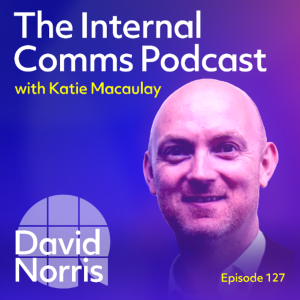
What's really holding you back, with David Norris (#127)
November 19, 2025
‘The qualities that matter most are not technical skills, but inner resources’ is the central thesis of comms coach David Norris’ work. Good news if you don’t want to read ...
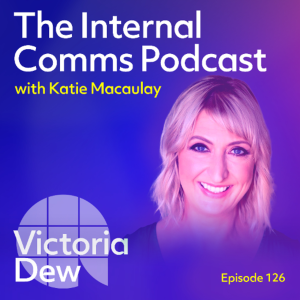
Cracking the frontline code – with Victoria Dew (#126)
November 5, 2025
In this episode, Katie welcomes back the Internal Comms Podcast’s MVP, founder and CEO of Dewpoint Communications Victoria Dew. Back in 2022, Victoria featured on episode 61 of ...

Ryanair’s exercise in efficiency – with James O’Connor (#125)
October 22, 2025
Ryanair flies 200 million passengers to 37 countries in 600 aircraft, a huge operation with a pop-cultural reputation for cheap cheap flights and frank, tongue-in-cheek communicati...
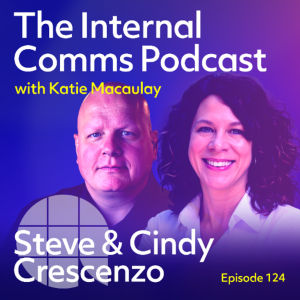
Kicking corporate clichés to the curb with Steve and Cindy Crescenzo (#124)
October 8, 2025
Episode #124 of the Internal Comms Podcast is a joint interview with returning guest Steve Crescenzo and his business partner and wife Cindy. Together, with host Katie Macaulay, th...

Don’t post, participate – with Roger Christie (#123)
September 24, 2025
In this episode, host Katie Macaulay learns how to get social media right. Tough ask? Not when you’ve got Roger Christie on hand to help. For the past 15 years the founder of ...

The science of happiness (and why we get it wrong) – with Professor Catherine Sanderson (#122)
September 10, 2025
Season 14 of the Internal Comms Podcast kicks off with a conversation about happiness. Host Katie Macaulay welcomes Professor Catherine Sanderson to discuss what really makes us...

Episode 121 – The story behind Bupa's elephant
June 25, 2025
In this episode of The Internal Comms Podcast, Katie Macaulay is joined by Jo Hudson, Group Director of Internal Communication at Bupa. Jo has spent the past 16 years at Bupa, one...
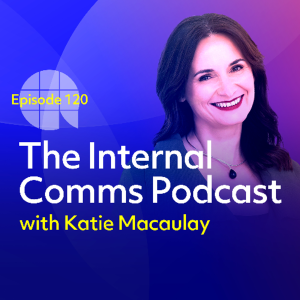
Episode 120 – Walk the line – how to stay in sync
June 11, 2025
In this episode of The Internal Comms Podcast, host Katie Macaulay sits down with alignment strategist and leadership coach Zora Artis to explore a crucial question: how can intern...

Episode 119 – The suite spot – Microsoft minus the mayhem
May 28, 2025
If the platforms you use at work were built by Microsoft, this episode is essential listening. Katie is joined by Alex Graves, Chief Visionary Officer at Silicon Reef — the peop...

Episode 118 – Satirising the spin – a bullsh*t investigation
May 14, 2025
If you have ever found yourself circling back, touching base, breaking down silos or leveraging strategic synergies — then these guests are speaking your language. Charles Firth...

Episode 117 – From humanising a prime minister to empowering the quietest voices
May 12, 2025
What does it take to make one of the most scrutinised leaders in the world feel relatable? And how do we build internal comms that truly include everyone — especially the quieter...
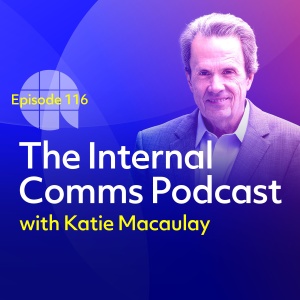
Episode 116 – How to build a remarkable career without a plan
April 7, 2025
Fred Cook’s career proves success doesn’t require a straight line. Now Chairman Emeritus of global PR agency Golin, Fred has spent 35+ years advising world-famous brands – Am...
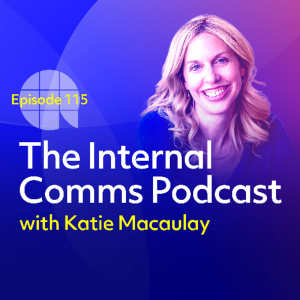
Episode 115 – Curiosity, creativity & the imposter myth
March 26, 2025
Inspiration is everywhere when you stay curious. That’s the thread running through this episode of The Internal Comms Podcast, where Katie Macaulay welcomes communication, creati...

Episode 114 – The credibility code: Become the leader your team deserves
March 12, 2025
What does it mean to be a credible leader? And just how important is that credibility to your team? In this episode of The Internal Comms Podcast, host Katie Macaulay welcomes back...
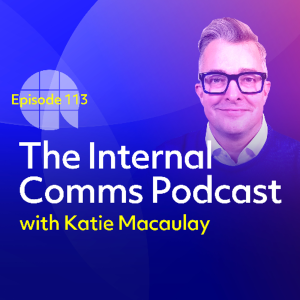
Episode 113 – Soft skill? Think again: The hard truth about storytelling
February 26, 2025
In this episode of The Internal Comms Podcast, host Katie Macaulay welcomes Jeremy Connell-Waite, Global Communications Designer for IBM, an acclaimed speechwriter and storyteller,...
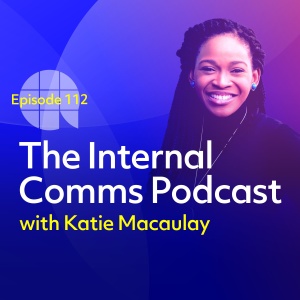
Episode 112 – From intent to impact: take charge of your career
February 20, 2025
We’re back for season 13 of The Internal Comms Podcast and to kick things off, host Katie Macaulay is joined by Eduvie Martin. Eduvie is Group Communications and Engagement Manag...

Season 12 – 2024 Christmas Special: nine gifts from the archive
December 18, 2024
In this episode, we mark a big milestone with a gift-wrapped edition of the Internal Comms Podcast. It’s six years since the show launched and, in this Christmas special, host K...
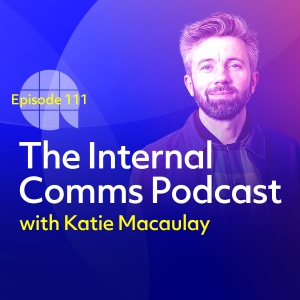
Episode 111 – A creative leader's blueprint for brilliance
December 4, 2024
This week on The Internal Comms Podcast, host Katie Macaulay is joined by a very special guest – AB's creative director, Joel O’Connor. Joel has been with AB for well over a de...
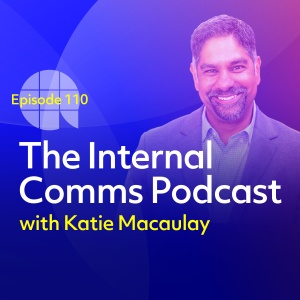
Episode 110 – Navigating the shifting digital landscape
November 20, 2024
This week on The Internal Comms Podcast, host Katie Macaulay is joined by co-founder of Local Wisdom, tech expert and comms leader Pinaki Kathiari. With his rare passion for both t...
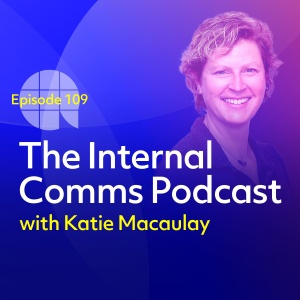
Episode 109 – The business of belonging: A new approach to DEI
November 6, 2024
We all deserve the opportunity to thrive at work. We deserve equal opportunity. We deserve to feel valued and included. That’s what diversity, equity and inclusion (DEI) is all a...
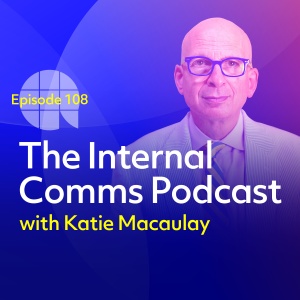
Episode 108 – Seth Godin rewrites the rules of internal communication
October 23, 2024
In this episode, Katie Macaulay is joined by author and influential blogger, Seth Godin. Seth was top of Katie’s guest wish list when The Internal Comms Podcast launched five ye...

Episode 107 – Beyond words: A blueprint for more impactful, immersive IC
October 9, 2024
In this episode of The Internal Comms Podcast, host Katie Macaulay welcomes international internal comms consultant and strategist Monique Zytnik to the hot seat. Monique is the au...
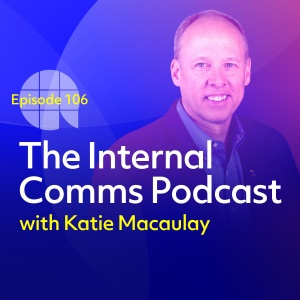
Episode 106 – School of thought: Inside Matt Tidwell’s comms curriculum
September 25, 2024
In this episode of The Internal Comms Podcast, host Katie Macaulay welcomes Matt Tidwell to the hot seat. Matt is a consultant, communicator and educator, and has led comms agencie...

Episode 105 – Reaching the peak of success: IC at Iron Mountain
September 11, 2024
We’re back for Season 12 of The Internal Comms Podcast, and in this first episode, host Katie Macaulay is joined by Senior Director of Corporate Communication at Iron Mountain, N...
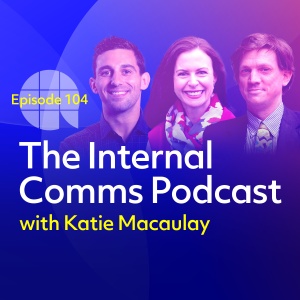
Episode 104 – Communications excellence in times of rapid change
July 31, 2024
McKinsey & Company is one of the world’s most renowned strategic management consultancies. With a mission of striving for “change that changes everything”, its global team of...
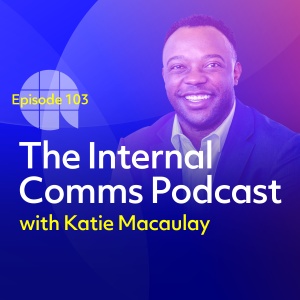
Episode 103 – Say the thing now: Candid conversations at Reddit
July 10, 2024
On a platform where the candid and the curious are king, how do you make sure what’s inside reflects what’s on the outside? Meet Sean Langston, Jr., Head of Internal Communicat...
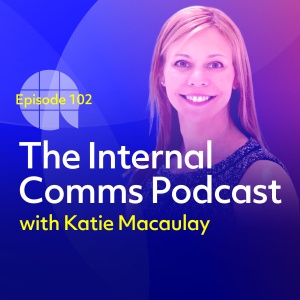
Episode 102 – The sound of success: IC at Spotify, Mastercard and beyond
June 26, 2024
Ever been curious about how some of the biggest brands in the world tackle their internal communication challenges? Well look (or listen) no further. Kerri Warner, this week’s gu...

Episode 101 – From complex to clear: Elevate your presentations
June 12, 2024
As internal communicators, empowering leaders to clearly communicate business strategy, important updates and company values is a valued skill. How can we inspire colleagues and le...
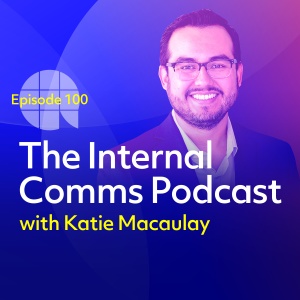
Episode 100 – Meet the super-connector behind #CommsJobs
May 29, 2024
After years running an internal communications team, Daniel Mendez emigrated from Chile to the U.S., where he faced a host of barriers to success. A language barrier. A small or no...

Episode 99 – The communicator’s communicator
May 15, 2024
In this episode of The Internal Comms Podcast, host Katie Macaulay is joined by Linda Zebian. The very first Director of Communications at PR management platform Muck Rack, Linda s...
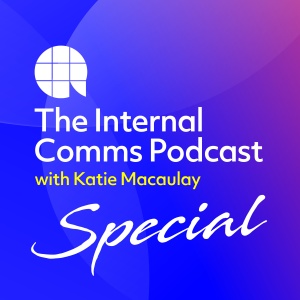
Exclusive reveal: Katie’s IC masterclass
May 1, 2024
Join us for a special episode of The Internal Comms Podcast as host Katie Macaulay announces the imminent launch of her unique on-demand masterclass. With more than three decades ...
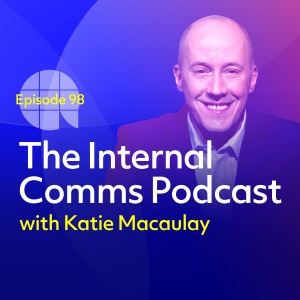
Episode 98 – How to build a powerful personal brand
April 17, 2024
This week on The Internal Comms Podcast, host Katie Macaulay is joined by serial entrepreneur, author, keynote speaker and business mentor Chris Ducker. Chris is a renowned expert ...
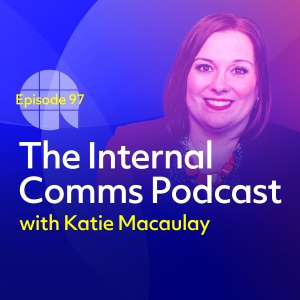
Episode 97 – Leaving the ladder down: helping IC pros step up
April 3, 2024
In this episode of The Internal Comms Podcast, host Katie Macaulay welcomes back the show’s first-ever guest, Rachel Miller. Rachel is an internationally recognised internal com...

Episode 96 – Inclusion in action: Kindness is the keystone
March 20, 2024
This week on The Internal Comms Podcast, host Katie Macaulay is joined by Global Belonging, Equity and Impact Consultant, and self-styled ‘human-centric technologist’, Bob Wata...

Episode 95 – Mastering your approach to strategic communication
March 6, 2024
This week on The Internal Comms Podcast, host Katie Macaulay is joined by award-winning marketing and communications expert Danielle Bond. Recently retired from corporate life, Da...
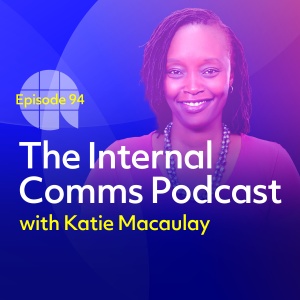
Episode 94 – The stories that shape us
February 21, 2024
In this episode of The Internal Comms Podcast, host Katie Macaulay is joined by leadership communications coach and co-founder of Engage Kenya, Agatha Juma. Agatha credits an emba...
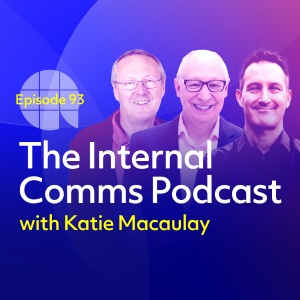
Episode 93 – The sound of success: Why it pays to listen to employees
February 7, 2024
We’re back for Season 11 of The Internal Comms Podcast! And kicking us off with a very special episode, this week host Katie Macaulay is joined by not one, not two, but three gue...
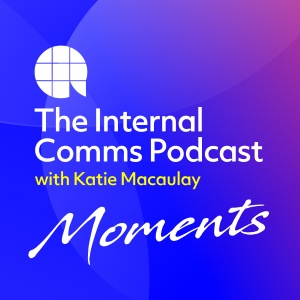
Moment 35 – The four Cs of content: How internal communicators can create comms that land
January 31, 2024
Looking for tips on creating internal communications that land – and stick? In this Moment from The Internal Comms Podcast, Steve Crescenzo shares a few things you absolutely mus...
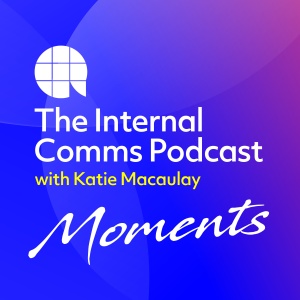
Moment 63 – Are you listening? The power of questions in leadership: Mike Roe
January 24, 2024
“I realised I was probably a pretty crap listener,” Mike Roe tells Katie Macaulay in this Moment from The Internal Comms Podcast. We often go to leaders and start by asking th...

Moment 57 – Language matters: Building two-way engagement at IKEA
January 17, 2024
At IKEA, choosing the right words when communicating with the workforce is everything. Guy Britt, IKEA’s Global Head of Co-worker Comms, tells Katie Macaulay the use of ‘co-wo...
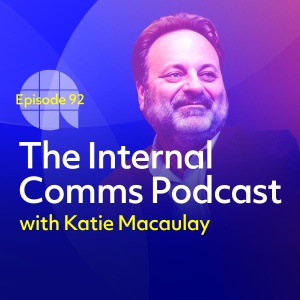
Episode 92 – Revolution coming: How AI is transforming internal comms
December 20, 2023
If you have ever attended one of Shel Holtz’s presentations, you will know that, more often than not, it’s standing room only. Shel has a remarkable ability to anticipate what'...
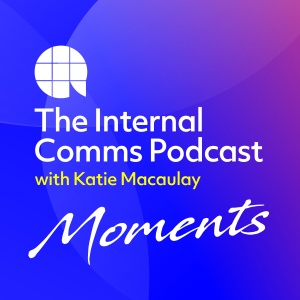
Moment 61 – Human-centric businesses do better: Victoria Dew
December 6, 2023
Does your approach to internal communication have the human touch? It’s essential to the humans you employ, says Victoria Dew, CEO of Dewpoint Communications and an internal com...
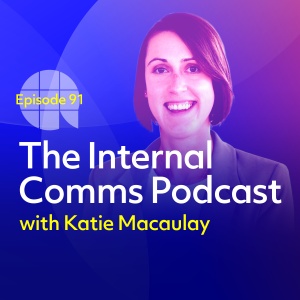
Episode 91 – How to build a one-person IC powerhouse
November 22, 2023
Ever feel like, as an internal communicator, you’re fighting an uphill battle all by yourself? This week’s guest on The Internal Comms Podcast has exactly what you need. Host ...
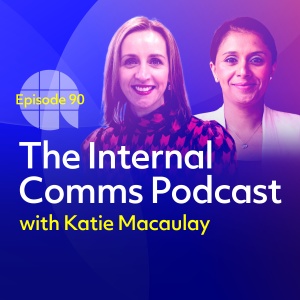
Episode 90 – A shared vision: ED&I and IC in action
November 8, 2023
This week on The Internal Comms Podcast, host Katie Macaulay is joined by Sim Sian, Head of Equality, Diversity and Inclusion at Mitie, and Yvonne O’Hara, formerly Mitie’s Grou...
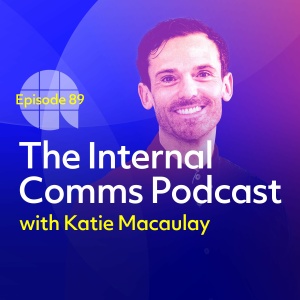
Episode 89 – Netflix-style IC: Snackable, on-demand and authentic
October 25, 2023
In this episode of the Internal Comms Podcast, host Katie Macaulay is joined by Access Group’s Global Head of Communications and Engagement, Paul Downey. Paul caught Katie’s ...
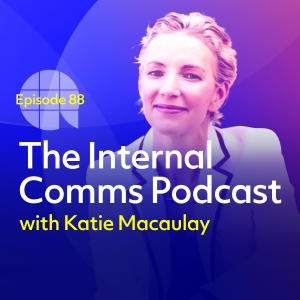
Episode 88 – It’s fixable: How to tackle hard problems
October 11, 2023
In this episode of the Internal Comms Podcast, host Katie Macaulay is joined by Anne Morriss. Anne is an entrepreneur, author, public speaker, and the Executive Founder of the Lea...
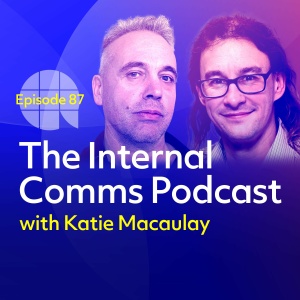
Episode 87 – Tracing the legacy of internal comms
September 27, 2023
It’s often said we must understand the past to build the future, and that sentiment sits at the very heart of this episode. This week on The Internal Comms Podcast we welcome pr...
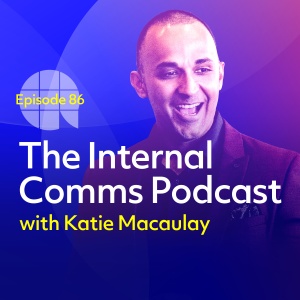
Episode 86 – How to crush your next public speaking gig
September 13, 2023
Season 10 of the Internal Comms Podcast kicks off with one of Katie’s most compelling conversations yet. Shil Shanghavi is a public speaking specialist, storyteller and head of...

Coming soon: Season 10 of The Internal Comms Podcast
September 6, 2023
Our summer break is drawing to a close, Katie has dusted off her mic and we’re ready to launch Season 10 of The Internal Comms Podcast! This season, we’ll be welcoming more o...

Moment 18 – 3% of employees are driving 90% of conversations: Mike Klein
August 30, 2023
In this moment, we catch up with Mike Klein, former political consultant, modern-day communications stalwart, and two-time guest on the Internal Comms Podcast. Mike breaks down h...
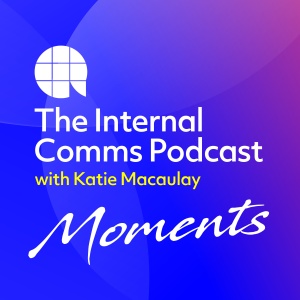
Moment 17 – How we create meaning: Sue Dewhurst & Liam FitzPatrick
August 23, 2023
What’s our one true purpose as internal communicators? It’s the question we’re all seeking the answer to. This moment takes us back to when Katie first welcomed Sue Dewhurs...
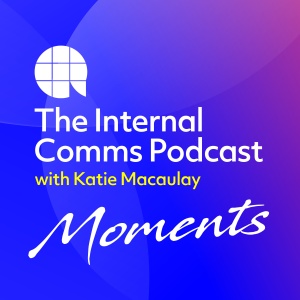
Moment 13 – The message must change at each leadership level: Dr Kevin Ruck
August 16, 2023
If there’s one thing we’re clear about at AB, it’s that communication should not be a one-way street. And that’s what this moment is about. We head back to Episode 13, w...

Moment 06 – On tolerance, kindness and being enough: Henry Normal
August 9, 2023
As communicators, we could often do with slowing things down a little. In this moment, Henry Normal – author and co-founder of production company Baby Cow, which he founded with ...

Moment 01 – What happens inside is reflected outside: Rachel Miller
August 2, 2023
Have you heard of an inside-out approach to communication? It’s no secret that today’s internal comms messages seep into the world outside the office walls. After all, anythi...

Episode 85 – Lessons from a trailblazer
July 26, 2023
We’re ending Season 9 of the Internal Comms Podcast with a bang this week, as Sally Susman takes to the hot seat for her second appearance. Sally is Executive Vice President an...
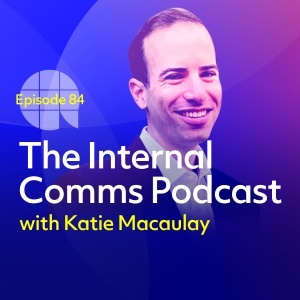
Episode 84 – Ethics in action: Insights from a global compliance leader
July 12, 2023
In modern business, integrity is non-negotiable. As legislation ramps up in lockstep with colleague and customer demands, operating an ethical business in line with global regula...
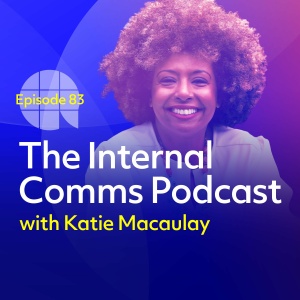
Episode 83 – ESG: How IC can drive the agenda
June 28, 2023
Define ESG… Well, it stands for environment, social and governance. But can you really define what ESG actually is? Put very simply, ESG is a set of criteria used to evaluate a ...
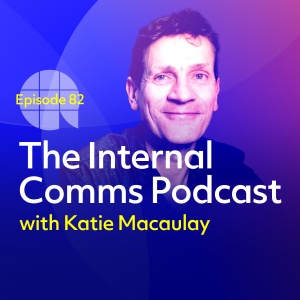
Episode 82 – The truth about resilience
May 31, 2023
It seems everyone’s talking about resilience, the ability to bounce back from misfortune or adversity. But as Bruce Daisley explains to host Katie Macaulay, there’s something w...

Episode 81 – Unilever: Inside a global success story
May 17, 2023
With over 130,000 colleagues, and a 100-year history, Unilever is one of the world’s largest consumer goods companies. And this week on the Internal Comms Podcast, we get a peek ...

Episode 80 – The inside track on comms at Mercedes F1
May 3, 2023
“The days we fail are the days our competitors live to regret,” said the late, great Niki Lauda. And that’s what this episode of the Internal Comms Podcast is all about. Thi...
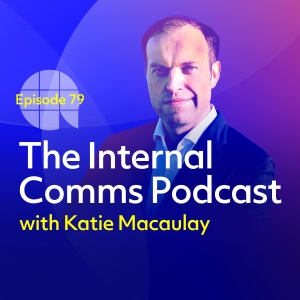
Episode 79 – Lifting the lid on comms consultancy
April 19, 2023
Ever considered what it takes to become an effective communications consultant? Then this week’s episode of The Internal Comms Podcast is for you. Host Katie Macaulay welcomes Si...
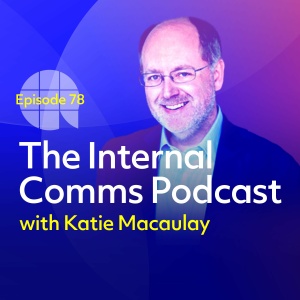
Episode 78 – Comms with courage
April 5, 2023
This week on The Internal Comms Podcast, host Katie Macaulay welcomes Audacity’s Jason Anthoine. Jason has spent three decades working in internal communication, employee experie...
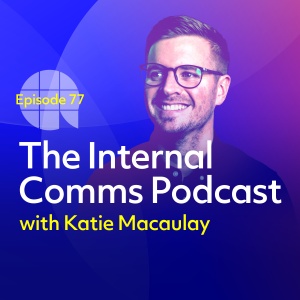
Episode 77 – Here for the culture
March 22, 2023
This week on The Internal Comms Podcast, host Katie Macaulay welcomes culture-chameleon Shane Hatton. Shane is many things – author, international speaker, trainer, leadership co...
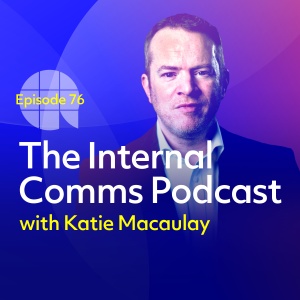
Episode 76 – Employee experience: For the people by the people
March 8, 2023
This week on The Internal Comms Podcast, host Katie Macaulay welcomes Nicholas Wardle. Nicholas is Head of Employee Experience at Brand Experiences, and co-author of ‘Monetising ...
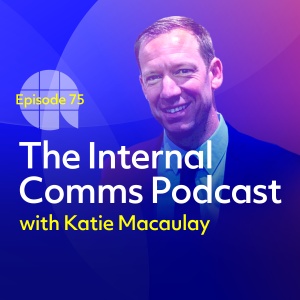
Episode 75 – Inside the world’s most famous corner shop
February 22, 2023
This week on The Internal Comms Podcast, host Katie Macaulay welcomes Sam Bleazard. Sam’s role as Employer Brand Content Producer takes him behind the scenes of ‘the world’s ...

Episode 74 – Culture with sticking power
February 8, 2023
The Internal Comms Podcast is back for Season 9! To kick off this season, we welcomed BizJuicer’s Andy Goram to the hot seat. Andy’s passion for building businesses ‘from t...
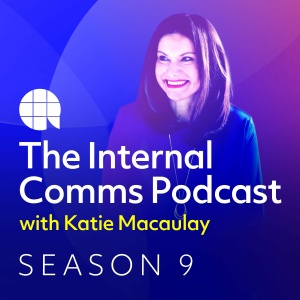
Season 8: In the rear view mirror
February 1, 2023
With Season 9 of The Internal Comms Podcast right around the corner, host Katie Macaulay has taken the opportunity to reflect on the wisdom and insight shared over our latest seaso...

Episode 73 – Forging your own path
December 21, 2022
The season 8 finale features Jennifer Thomas, Head of Communications for the Data & Analytics branch of the London Stock Exchange Group. Born in London to Guyanese parents, Jennif...

Episode 72 – Making your way to the top
December 7, 2022
Episode 72 of The Internal Comms Podcast sees host Katie Macaulay joined by Adrian Cropley, CEO and founder of Cropley Communication and the Centre for Strategic Communication Exce...
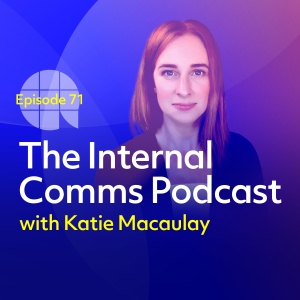
Episode 71 – Effective comms starts with knowing yourself
November 23, 2022
This week’s guest on The Internal Comms Podcast is Joanna Parsons, Head of Internal Communications & Culture at Teamwork. Joanna made Irish history as the first ever Head of Inte...
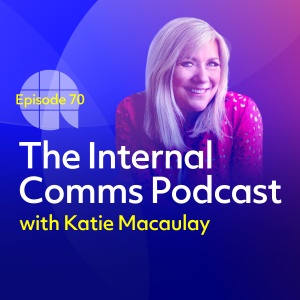
Episode 70 – Reaching across the aisle
November 9, 2022
Shelby Scarbrough, author of 'Civility Rules! Creating a Purposeful Practice of Civility', shares her deep insight and experience ‘reaching across the aisle’ on episode 70 of T...

Episode 69 – Measuring what matters – actions not feelings
October 26, 2022
Episode 69 of The Internal Comms Podcast sees IC heavyweight Mike Klein return to the hot seat. An internal and social communication consultant based out of Reykjavik, Mike is help...
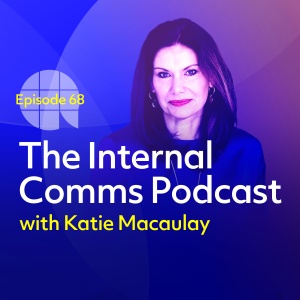
Episode 68 – Host in the hot seat: Reflections on 250,000 plays
October 12, 2022
In this very special episode of The Internal Comms Podcast, the tables have turned. Katie Macaulay is in the hot seat, and AB’s Senior Content Editor Freddie Reynolds takes over ...
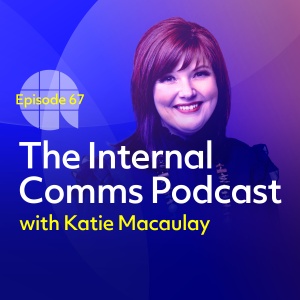
Episode 67 – The ABC of research: Ask, believe, change
September 28, 2022
In this episode of The Internal Comms Podcast, host Katie Macaulay invites qualitative research expert Mari Lee to sit in the hot seat. Mari’s specialism is in ‘development com...
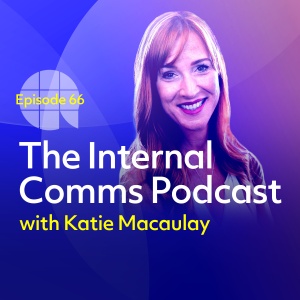
Episode 66 – Combatting IC isolation
September 14, 2022
The Internal Comms Podcast is back for what promises to be an incredible Season 8! In this kick-off episode, host Katie Macaulay welcomes ICology’s Vice President of Community an...
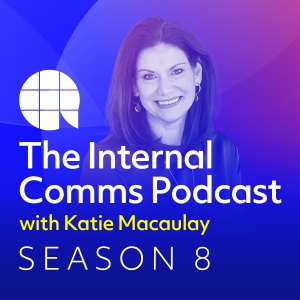
Season 7: The rewind episode
September 7, 2022
The countdown is on, and The Internal Comms Podcast will be returning from its summer break with Season 8 imminently. And while its eighth instalment promises wisdom unbound from a...

Episode 65 – Remote but not unreachable
June 22, 2022
In the final episode of season 7 of The Internal Comms Podcast, host Katie Macaulay speaks with Lily Goodman D’Amato, Delivery Trainer at US-based digital pharmacy Medly. Lily b...
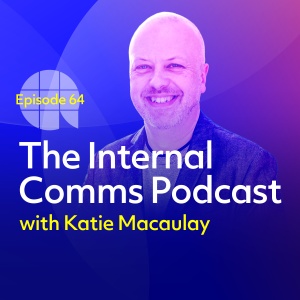
Episode 64 – Releasing your inner sceptic
June 8, 2022
In the latest episode of The Internal Comms Podcast, host Katie Macaulay speaks with Martin Flegg, founder and co-owner of The IC Citizen internal communications consultancy. With...

Episode 63 – Lessons in leadership
May 25, 2022
In episode 63 of The Internal Comms Podcast, host Katie Macaulay meets Mike Roe, who had a 28-year career in the police force and is now CEO of Tensense, a data insights company. ...

Episode 62 – Textbook IC: rewriting comms for a new era
May 11, 2022
In the latest episode of The Internal Comms Podcast, host Katie Macaulay speaks with the duo who wrote the book on internal communications – literally. Sue Dewhurst has worked i...

Episode 61 – Embracing the messiness of being human
April 27, 2022
In this week’s episode of The Internal Comms Podcast, host Katie Macaulay sits down with Victoria Dew, founder and CEO of Dewpoint Communications. Her firm is focused on helping ...
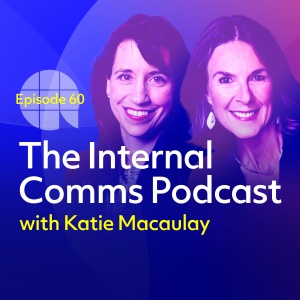
Episode 60 – How to have better conversations
April 13, 2022
In this week’s episode of The Internal Comms Podcast, host Katie Macaulay sits down with Jackie Stavros and Cheri Torres, co-authors of Conversations Worth Having, Using Apprecia...
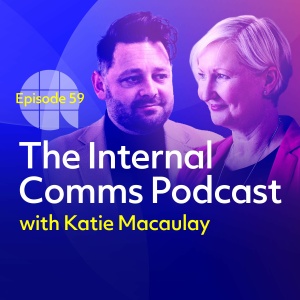
Episode 59 – Strategy & IC: A masterclass in collaboration
March 30, 2022
In this episode of The Internal Comms Podcast, host Katie Macaluay looks into the dynamic between internal comms and strategy – at its best a symbiotic relationship that drives t...
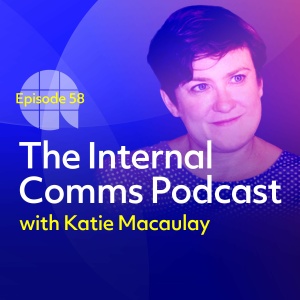
Episode 58 – The state of IC: what’s behind the numbers?
March 16, 2022
In episode 58 of The Internal Comms Podcast, we dissect the results of the latest State of the Sector report, the definitive global survey of the internal communication landscape, ...

Episode 57 – Unboxing internal comms at IKEA
March 2, 2022
In episode 57 of The Internal Comms Podcast, listeners can take a peek inside the world of IC at IKEA, as host Katie Macaulay chats with a dynamic duo from the multinational furnit...
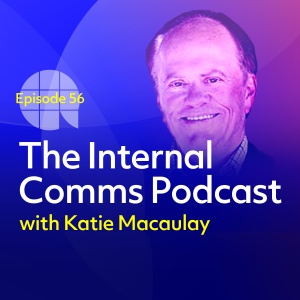
Episode 56 – IC at the sharp end
February 16, 2022
In this first episode of season 7 of The Internal Comms Podcast, host Katie Macaulay talks to Jim Shaffer, an internationally recognised business adviser, leadership coach, author ...
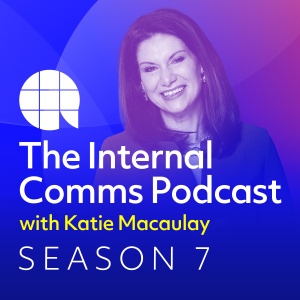
Leading Lights – Highlights From Season 6
February 9, 2022
Get ready to tune in to our next season of The Internal Comms Podcast. While Season 7 promises an amazing array of guests, this special episode highlights some of the best moments ...
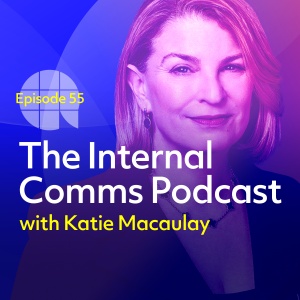
Episode 55 – Mission Possible
December 1, 2021
In the final episode of season 6 of The Internal Comms Podcast, host Katie Macaulay speaks to Sally Susman, Executive Vice President and Chief Corporate Affairs Officer at Pfizer. ...
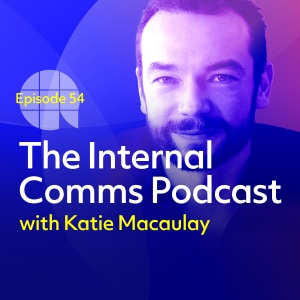
Episode 54 – Brain care: Mastering your mind
November 17, 2021
In the sixth episode of season 6 of The Internal Comms Podcast, host Katie Macaulay talks to Phil Dobson, founder of BrainWorkshops and author of The Brain Book: How to Think and W...

Episode 53 – Suicide Prevention: Reflecting on an award-winning campaign
November 3, 2021
***The content in this episode of The Internal Comms Podcast may be triggering for those who have experience of suicide.*** In the fourth episode of season 6 of The Internal Comms...
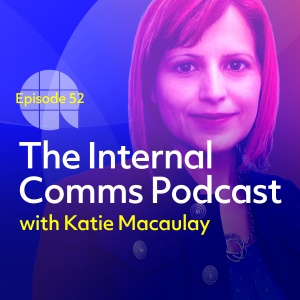
Episode 52 – How do you create comms with purpose?
October 20, 2021
In the fourth episode of season 6 of The Internal Comms Podcast, host Katie Macaulay catches up with Maliha Aqeel, Director of Global Communications and Digital Channels at Fix Net...

Episode 51 – Why are we here? How purpose and values drive healthy cultures
October 6, 2021
In the third episode of season 6 of The Internal Comms Podcast, host Katie Macaulay catches up with communications expert and IABC Fellow Jane Mitchell. Jane began her career with...
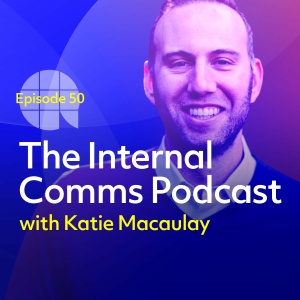
Episode 50 – A guru’s guide to internal podcasts
September 22, 2021
In the second episode of season 6 of The Internal Comms Podcast, host Katie Macaulay talks to Brian Landau, an authority in podcasting and expert on all things audio content creati...

Episode 49 – Engagement: how it started, how it's going
September 8, 2021
In this first episode of season 6 of The Internal Comms Podcast, host Katie Macaulay talks to the father of employee engagement, organisational psychologist Professor William Kahn....
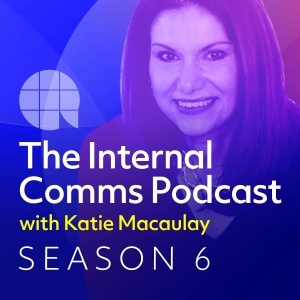
Industry experts – highlights from Season 5
September 1, 2021
The curtain is about to go up on the new season of The Internal Comms Podcast, with some fantastic guests joining host Katie Macaulay to talk about all things communication. For t...
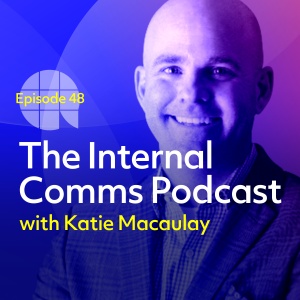
Episode 48 – Changing minds: using behavioural science in IC
May 12, 2021
It has always been Katie Macaulay’s goal for The Internal Comms Podcast to help improve the way organisations communicate with their people, and this week she does so by explorin...
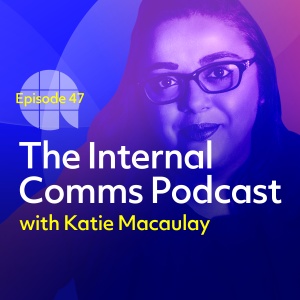
Episode 47 – Conversation with a comms rebel
April 28, 2021
Katie Macaulay’s guest this week is a leading light in efforts to advance the careers of under-represented groups in IC. Advita Patel is a qualified coach, mentor, public speake...

Episode 46 – Influential Internal Communication
April 14, 2021
This episode sees the return of the brilliant business communications strategist, international public speaker and podcast host Jenni Field. The immediate past chair of the Charte...
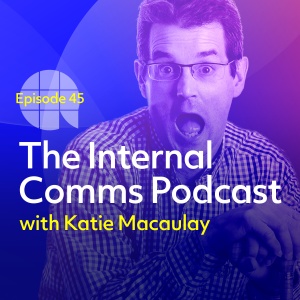
Episode 45 – Sharing the magic
March 31, 2021
The life and career of this week’s guest has been a literal roller coaster. Mark Webb fell into PR and media relations by chance, after spotting a job ad for the new Eurodisney ...
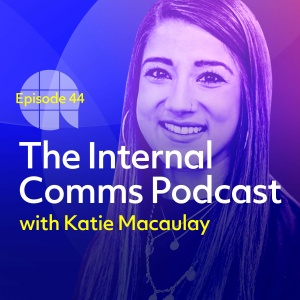
Episode 44 – How to prove your presence
March 17, 2021
Katie Macaulay’s guest for episode 44 of The IC Podcast is Canadian comms expert Prarthna Thakore. After beginning her career in Calgary and then moving to London, Prarthna has ...
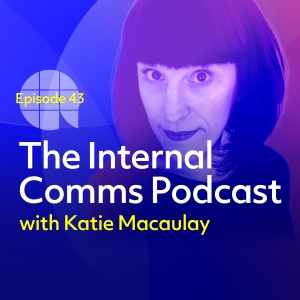
Episode 43 – Kate Jones on the state of our sector
March 3, 2021
Every year since 2008, internal comms pros have responded to the Gallagher State of the Sector report. Because it’s been running for 13 years, and because similar questions are a...
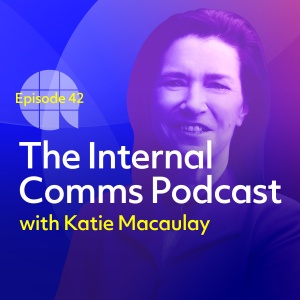
Episode 42 – Once Upon A Time In IC
February 17, 2021
Katie Macaulay kicks off Season 5 of The IC Podcast with a riveting conversation with business storytelling specialist Gabrielle Dolan. Gabrielle is a highly sought-after internat...

Looking back, looking forward: highlights from Season 4
February 10, 2021
With the new season of The Internal Comms Podcast just around the corner, we wanted to whet your appetite with a selection of the best bits from Season 4. For this special best-of...
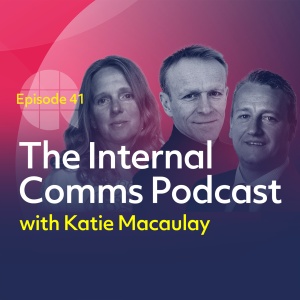
Episode 41 – At the heart of the crisis: NHS comms during Covid-19
December 23, 2020
The NHS has never been far from our hearts and minds over the last few months. As the national jewel in the UK’s crown, the National Health Service has battled many difficulties ...

Episode 40 – Founding fathers – building the first IC agency
December 17, 2020
What prompted the creation of the first IC agency back in 1964 and what convinced those first chief executives that they needed external help communicating with their employees? W...
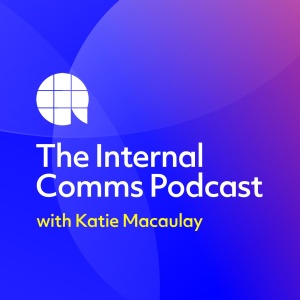
Coming soon in season 4
December 9, 2020
Coming soon in season 4 of The Internal Comms Podcast
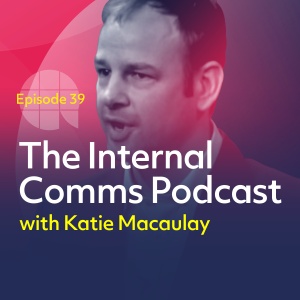
Episode 39 – Evidence-based IC
November 25, 2020
Recent research shows measurement is particularly challenging for many internal comms professionals. Katie’s guest on this episode of The Internal Comms Podcast is Benjamin Ellis...

Episode 38 – The secret thoughts of successful people
November 11, 2020
Amid the turmoil of 2020, with IC pros thrown into the spotlight as we strive to keep colleagues informed and connected, it’s not surprising that many of us are feeling a degree ...

Episode 37 – The art of negotiation
October 28, 2020
If you want to take your communication skills to the next level, then this episode of The Internal Comms Podcast is for you. Katie’s guest is a formidable negotiator and expert ...
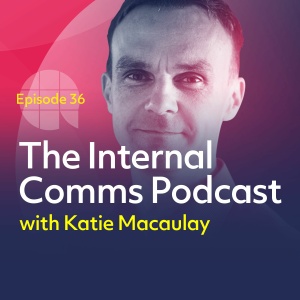
Episode 36 – Navigating the digital landscape
October 14, 2020
In this episode of The Internal Comms Podcast we meet digital expert Frank Wolf. Frank spent seven years as a business consultant at Accenture. Then at T Mobile, he was responsible...
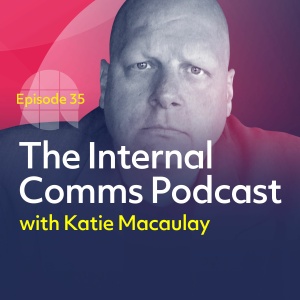
Episode 35 – How to do less, but do it better
September 30, 2020
In this episode of The Internal Comms Podcast we meet Steve Crescenzo, a witty, straight-talking and charismatic speaker, workshop leader and coach from Chicago, USA, who has spent...
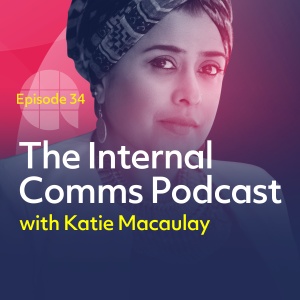
Episode 34 – Cross-cultural comms
September 16, 2020
The Internal Comms Podcast is now in its fourth season – and to kick it off Katie sat down with Tasneem Chopra for some honest and open conversation. The self-styled “professi...
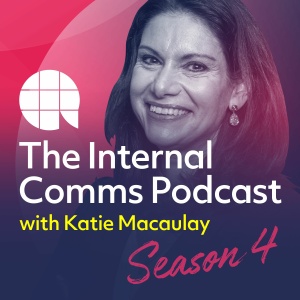
Choice cuts: highlights from Season 3 of The IC Podcast
September 2, 2020
Before the curtain lifts on Season 4 of The IC Podcast, we wanted to leave you with some food for thought from Season 3. And what a season it was; we had a whole host of remarkabl...
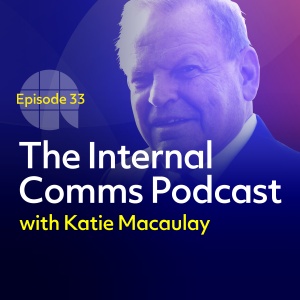
Episode 33 – IC’s founding father
July 8, 2020
The goal of this podcast is to bring you meaningful, in-depth conversations with people who are helping to shape the world of internal communication: practitioners, leaders, author...
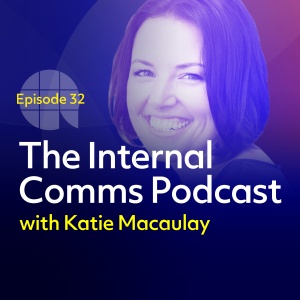
Episode 32 – Leadership in unprecedented times
June 24, 2020
President of the Chartered Institute of Public Relations (CIPR), Jenni Field has more than 16 years’ experience in communications. She is the founder and director of Redefining C...

Episode 31 – What's next? IABC roundtable on the impact of Coronavirus
June 10, 2020
The Internal Comms Podcast has gone truly global with our latest episode featuring three speakers from three countries. In episode 31 Katie tables a roundtable discussion with Jen...

Episode 30 – Your biggest, best, boldest self
May 27, 2020
Chief Executive of the Office for Nuclear Regulation (ONR), Adriènne Kelbie has an exceptional understanding of the true power of communication and engagement. The first woman to ...
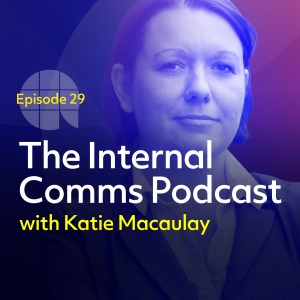
Episode 29 – Crisis communication at the coalface
May 13, 2020
Katie’s guest this week is someone who is no stranger to crisis communication. Amanda Coleman was the Director of Corporate Communication at Greater Manchester Police when, on M...
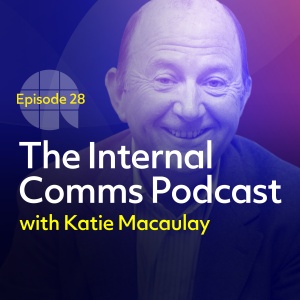
Episode 28 – The Godfather of IC
April 29, 2020
Katie’s guest this week is one of the world’s leading authorities on internal comms and the management of change: Bill Quirke. As managing director of IC consultancy Synopsis,...
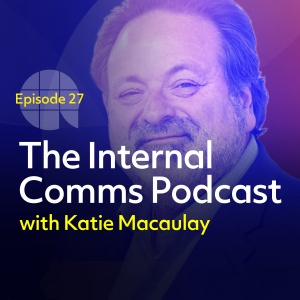
Episode 27 – Stepping up in a Crisis
April 14, 2020
This week Katie speaks to renowned communicator Shel Holtz. As listeners continue to grapple with keeping workforces informed, galvanised and feeling connected during the corona cr...
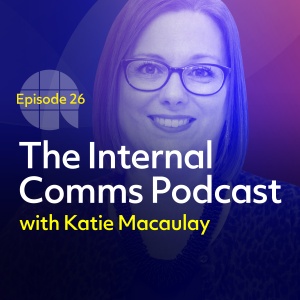
Episode 26 – How to thrive in IC (Part II)
April 1, 2020
This episode is recorded as the majority of the UK is in lockdown while the country attempts to flatten the curve of the COVID-19 pandemic. Katie Macaulay’s guest, Rachel Miller...
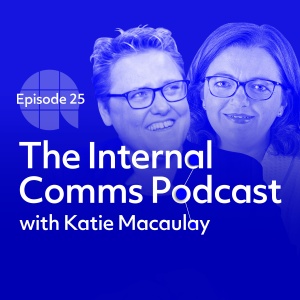
Episode 25 – Crisis Communications: Covid-19 Special
March 25, 2020
Katie Macaulay recorded this special episode on Friday 20 March 2020 in response to the rapidly developing situation surrounding the Covid-19 pandemic. Her guests to talk all thin...

Episode 24 – A view from the top
March 18, 2020
In this episode of The Internal Comms Podcast, Katie puts her first CEO in the hotseat: Marc Barone. Marc is chief executive for continental Europe at AECOM. This Fortune 500 comp...
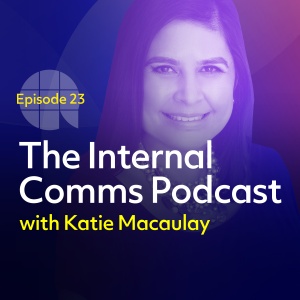
Episode 23 – Courage, confidence and communication
March 4, 2020
In this episode of The Internal Comms Podcast Katie talks to one of world’s most qualified communicators, Priya Bates, from Canada. Priya has an Accredited Business Communicator...
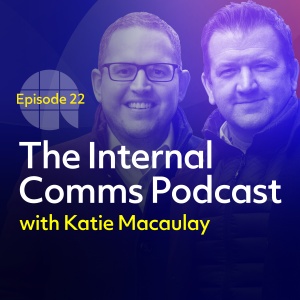
Episode 22 – State of the Sector
February 19, 2020
State of the Sector is the longest-established and most in-depth survey of the internal communication profession, based on responses from more than 1,000 professionals around the w...
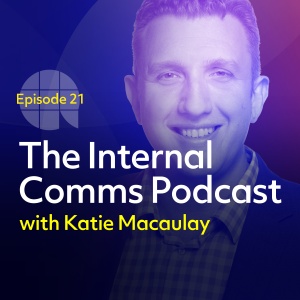
Episode 21 – The cheerleader for IC
February 5, 2020
During Seasons One and Two we covered a lot of ground in IC and beyond. As we begin Season Three, brace yourself for more fascinating insights as we delve into the very heart of co...

The highlight reel – nuggets of wisdom from Season 1 and 2 of The IC Podcast
January 29, 2020
Since the launch of The Internal Comms Podcast, host Katie Macaulay has interviewed more than 20 fascinating guests from the world of IC and beyond. Now, as we gear up for Season ...
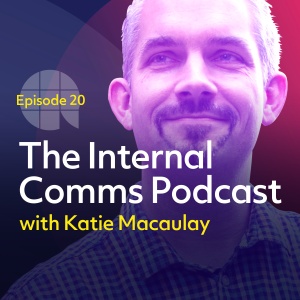
Episode 20 – Advocacy in action
December 18, 2019
Katie’s guest this week is Keith Lewis, UK Social Media and Social Business Manager for Zurich Insurance – one of the world’s largest insurance groups with 55,000 employees i...
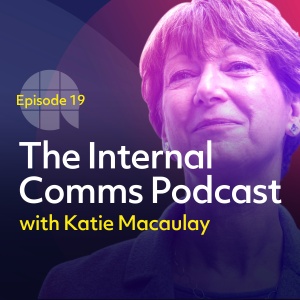
Episode 19 – The appliance of neuroscience
December 4, 2019
Katie Macaulay’s guest this week is a neuroscientist with extensive experience in the field of organisational change. Hilary Scarlett began studying the brain in 2009 after read...

Episode 18 – Editing organisations
November 20, 2019
In this episode we get up close and personal with someone who helps improve the way we communicate at work. Mike Klein worked as a political consultant in the US, but for the past...
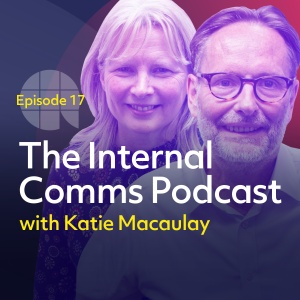
Episode 17 – Black Belt Thinking
November 6, 2019
As individuals, this week’s guests have impressive CVs. Sue Dewhurst is an experienced internal communicator who, for many years, has been training and coaching thousands of lea...
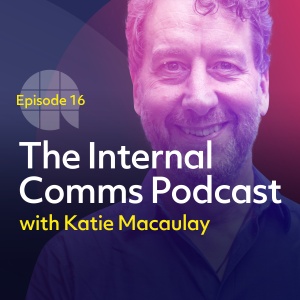
Episode 16 – A Passage to India
October 23, 2019
With this podcast now reaching listeners in 50 countries worldwide, host Katie Macaulay has chosen to go international for this episode. Her guest is creative services entrepreneu...
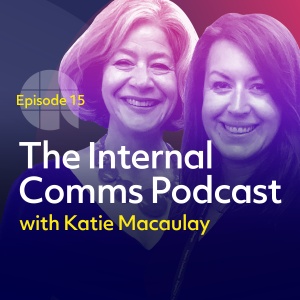
Episode 15 – The Power of Two
October 8, 2019
This week, Katie meets Claire Hyde and Louise Wadman, joint heads of IC at KPMG UK. Possibly the most senior IC job share in the country, Claire and Louise have more than 45 years...
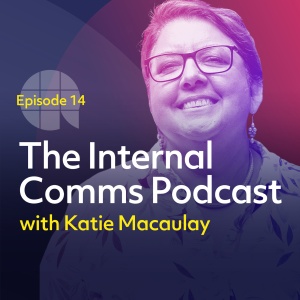
Episode 14 – How to start a movement
September 24, 2019
Katie’s guest this episode is Nita Clarke – whose services to employee engagement have earned her an OBE from the Queen. Nita has a long and fascinating career. She co-authore...

Episode 13 – A check-up with the IC doctor
September 11, 2019
The Internal Comms Podcast is back with a new series of fortnightly conversations with leading lights from the world of internal communications, engagement and leadership. AB Mana...
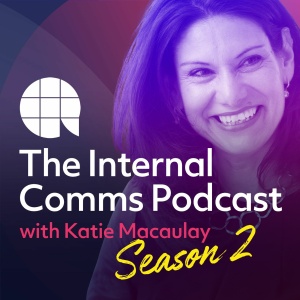
Season 02 Trailer
September 6, 2019
Season two of The Internal Comms Podcast is almost here!
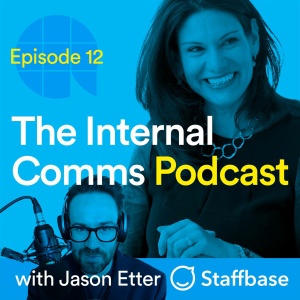
Episode 12 – Listen and learn: insights from 30 years in IC
July 24, 2019
In this extra special bonus episode of The Internal Comms Podcast, the tables are turned on Katie as she takes the spotlight as an interviewee. Posing the searching questions is J...
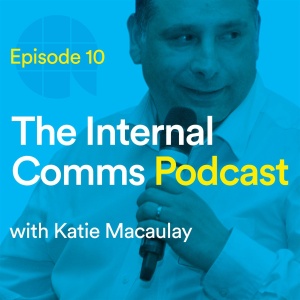
Episode 11 – Putting the soul back into Patisserie Valerie
June 25, 2019
For this special bonus episode of The IC Podcast, Katie interviewed Paolo Peretti, Managing Retail Director of Patisserie Valerie, in front of a live audience at AB Thinks Live, ou...
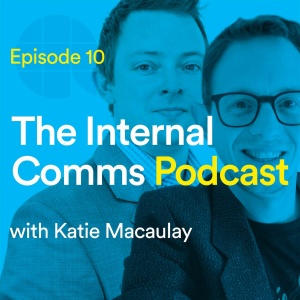
Episode 10 – Internal comms at the sharp end - recorded at IoIC live
May 21, 2019
For the final episode of season one, Katie Macaulay travels to Bath for IoIC Live and interviews two of the conference’s speakers, Martin Fitzpatrick and Matt Batten. Both Marti...
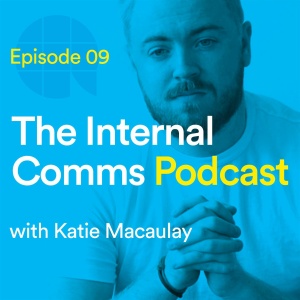
Episode 09 – How to win colleagues and influence people
May 7, 2019
Social influencer marketing is a new and rapidly growing means of getting your message out to your audience. It’s changed the face of advertising and has everyone from up-to-the-...
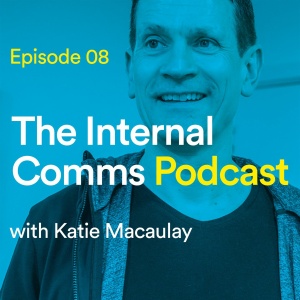
Episode 08 – The Joy of Work
April 23, 2019
Katie’s guest this week is an extremely versatile communicator. In his day job as European Vice President of Twitter, Bruce Daisley has overseen the development of one of the wor...

Episode 07 – What social purpose (really) means
April 9, 2019
Running the UK’s largest retail and financial services network with more branches than all of the UK’s banks and building societies put together, the Post Office is at the hear...
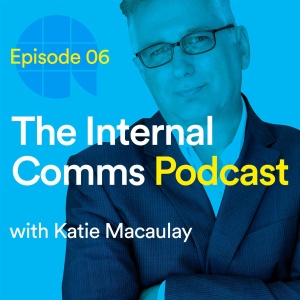
Episode 06 – The craft of communication
March 27, 2019
In episode six, Katie travels beyond the boundaries of internal comms to find out how to write more engagingly, tell better stories and use humour to deliver your message. And who ...
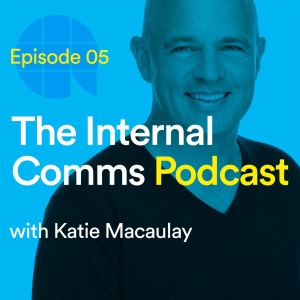
Episode 05 – Learning comms lessons from PR
March 13, 2019
In episode five, Katie aims to find out what internal communications can learn from external communications. So she sits down with ‘mister public relations’, Stephen Waddington...

Episode 04 – What it means to be the voice of IC
February 27, 2019
The Institute of Internal Communication (IoIC) is the voice of the IC profession – dedicated to strengthening confidence, credibility and community. And on 12 March, the IoIC cel...
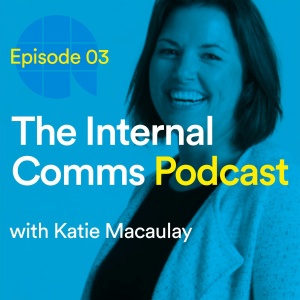
Episode 03 – What the State of the Sector report means for IC
February 13, 2019
Episode three lands as Gatehouse’s latest State of the Sector report is published. Katie invites Jenni Field, a tireless, high-profile personality of the IC landscape, to discus...
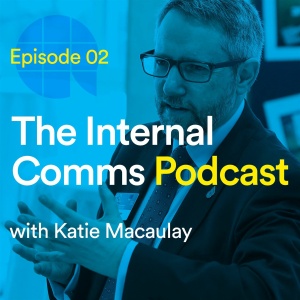
Episode 02 – What it takes to be an IC leader
January 30, 2019
Even if you’re only vaguely familiar with internal communications, Katie’s guest in episode two will no doubt be a name you recognise. In a career spanning 30 years, Russell G...
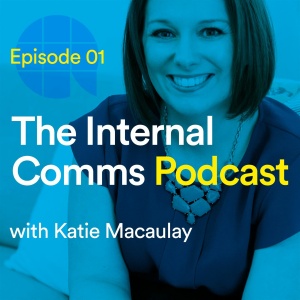
Episode 01 – How to thrive in IC
January 16, 2019
In the first episode of The Internal Comms Podcast, Katie meets Rachel Miller – a prolific blogger, educator, keynote speaker and one of the most respected voices in internal com...
